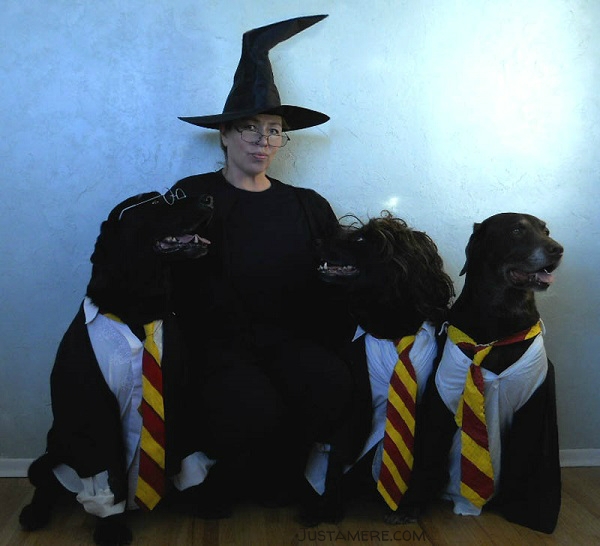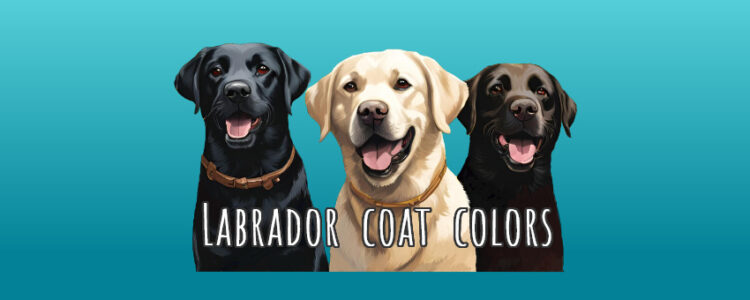
Have you ever wondered about Labrador coat colors? Such as how two black Labs can have chocolate and/or yellow puppies? Or why breeding a chocolate to a yellow often produces all black puppies?
Well, it’s genetics that determines Labrador coat colors. But before we get into all of that, did you know Labs come in four colors? Yep, and I’m not talking about the “designer” dogs in silver or charcoal. You’ve probably even seen all four colors and didn’t realize it.
So what are they?
The three Labrador coat colors (plus one)
Well, there’s black. No surprise there. There’s also chocolate. Again, no surprise.
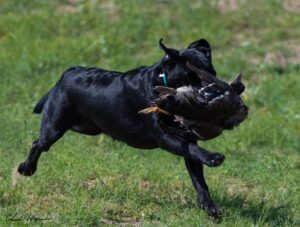
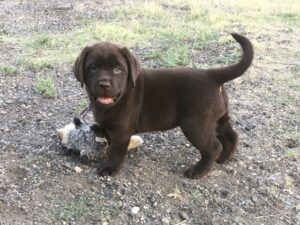
Then we get to the yellows. This color comes in shades from pale cream to rich fox red. They have a black nose and eye rims.
The fourth color looks like a yellow at first glance, but they have a chocolate nose and eye rims. These are called Dudleys and they carry the genes for both chocolate and yellow.
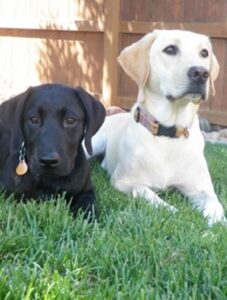
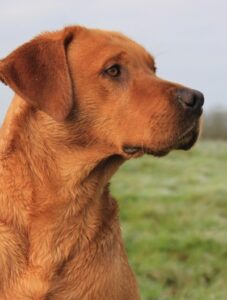
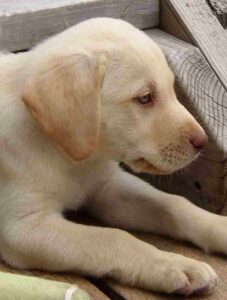
There’s nothing wrong with Dudleys, but they are disqualified in dog shows. Some people think these are light-colored chocolate Labs or a mixed breed. They are neither.
Genetic basics
To understand how the Labrador coat colors are inherited we have to take a look at some science. If there’s a term you don’t understand click to scroll down to Genetic terms.
The blueprint of each dog is contained in its DNA which is made up of 39 pairs of chromosomes. Half of those chromosomes came from the dog’s father and the other half came from the dog’s mother.
Along those chromosomes are genes. Each pair of genes controls a portion of that blueprint. The gene pairs can be the same which is written with two capital letters such as “BB” or two small letters such as “bb” (homozygous). Or they can be different (heterozygous) which is written with a capital and a small letter such as “Bb”.
If they are different, the dominant gene will show and the recessive gene will be hidden.
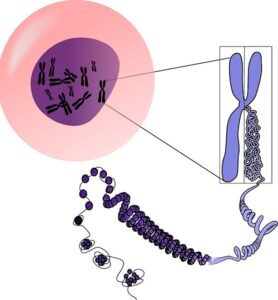
This is a cell with chromosomes and genes.
Applying genetics to Labrador coat colors
In Labs, the gene for black (“B”) is dominant to chocolate (“b”). The “B” or “b” shows that these are two versions of the same gene and that the one with the capital letter is dominant to the small letter.
If the dog has at least one of the “B” genes, he will be black. With an exception we’ll get to. So BB and Bb mean the dog is black, but bb means the dog is chocolate.
Yellow is determined by different genes which can be EE or Ee or ee. The “E” gene determines whether the dog will be yellow or not yellow. If the dog has one copy of the “E” version of the gene, he will be black or chocolate depending on the “B” gene. But if the dog has two copies of the “e” version he will be yellow. That is the exception. Usually a Lab with “BB” genes is black, but if he also has “ee” genes he will be yellow. In this case the yellow gene will override the black gene.
Labs with two copies each of the “b” and “e” genes (“eebb”) will be yellow with a chocolate nose and eye rims. These are the Dudleys. Other people say they’re “NBP” which is short for No Black Pigment.
Labrador coat colors
Okay, so that was a somewhat simplified version of genetics, now we can get into colors.
Dogs need at least one copy of the “B” gene to have a black nose and eye rims. If they also have at least one copy of the “E” gene, they will have a black coat.
A dog with two copies of the “b” gene will have chocolate pigment on the nose and eye rims. If he also has two copies of the “e” gene, his coat will be yellow. However if he has one or two copies of the “E” gene his coat will be chocolate.
Clear as mud? Here’s a chart:
| Lab Colors | Color Code | Description |
|---|---|---|
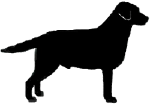 |
EEBB | Black, no hidden color |
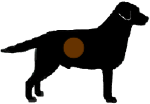 |
EEBb | Black with hidden chocolate |
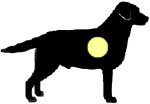 |
EeBB | Black with hidden yellow |
 |
EeBb | Black with hidden yellow and chocolate |
 |
EEbb | Chocolate with no hidden color |
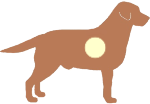 |
Eebb | Chocolate with hidden yellow |
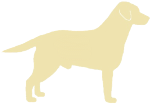 |
eeBB | Yellow with no hidden color |
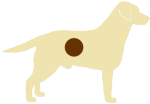 |
eeBb | Yellow with hidden chocolate |
 |
eebb | Yellow with chocolate pigment, including the nose and eye rims – a Dudley |
So those four colors we see break down into nine different colors when we look at the genetics.
Punnet Squares
A Punnet square makes it easier to calculate what colors and approximate percentages we might get in a litter. The father’s contribution is listed along the top and the mother’s contribution is along the side.
Let’s try combining the genes. For the sake of clarity we’ll start with just the black/chocolate gene. If both parents are black, but they carry the gene for chocolate their code is “Bb”.
So we put a “B” and a “b” across the top and a “B” and a “b” along the side.
Here’s how the square looks filled in:
| B | b | |
|---|---|---|
| B | BB | Bb |
| b | Bb | bb |
In this case the genes have a 25% chance of combining as “BB”, a 50% chance of combining as “Bb” and a 25% chance of combining as “bb”. Only the “bb” would show as chocolate.
If the litter size was large enough—more than 100—you would probably see a distribution of colors fairly close to these percentages. However because litter size is much smaller you could get all blacks or all chocolates or somewhere in between.
Here is yellow vs not yellow:
| E | e | |
|---|---|---|
| E | EE | Ee |
| e | Ee | ee |
The EE is basic black. Ee is black that has hidden yellow. And ee is yellow.
Combining the traits
If both parents are black and carry the genes for chocolate and yellow they would be “EeBb” (Ee = hidden yellow, Bb = hidden chocolate). That means they could have black, chocolate, yellow, and/or Dudley puppies.
Below is the Punnet Square combining both “B” and “E” genes. Can you figure out which combinations will be black? Or yellow? Or chocolate? No cheating!
| EB | Eb | eB | eb | |
|---|---|---|---|---|
| EB | EEBB | EEBb | EeBB | EeBb |
| Eb | EEBb | EEbb | EeBb | Eebb |
| eB | EeBB | EeBb | eeBB | eeBb |
| eb | EeBb | Eebb | eeBb | eebb |
Yeowie!! That looks a lot, but there’s really only nine different combinations. The percentages break down like this:
- 25% EeBb
- 12.5% EEBb
- 12.5% EeBB
- 12.5% Eebb
- 12.5% eeBb
- 6.25% EEBB
- 6.25% EEbb
- 6.25% eeBB
- 6.25% eebb
How about the chocolate bred to a yellow that produced all blacks? Was that a mistake?
| Eb | Eb | |
|---|---|---|
| eB | EeBb | EeBb |
| eB | EeBb | EeBb |
Well, let’s see. If dad is “EEbb” (chocolate) and mom is “eeBB” (yellow), all of their offspring will be “EeBb”. The dominant form of “E” is not yellow and the dominant form of “B” is black. So, all of the puppies will be black, but will carry the genes for both chocolate and yellow.
Determining parents’ color
You can also work backwards from the puppies to the parents. For example, if a black male has even one chocolate puppy in his lifetime, he is “Bb”. If he’s been bred to a few yellows and never produced a yellow puppy, he’s probably “EE”. However we wouldn’t know for sure without testing.
If a yellow female has been bred to a black male and they had black and yellow puppies, but no chocolates, what would you conclude? Well, we know dad carries yellow, because he had yellow puppies. But dad’s yellow is hidden so he’s “Ee” and mom is yellow so she’s “ee”.
Because dad is black he must have at least one “B”, but we don’t know anything about the other in the pair. He might carry chocolate while the mother doesn’t have it or she might carry chocolate and he doesn’t. Or it could be that neither carry chocolate. Or they could both carry chocolate and Mother Nature just didn’t pair the genes for the chocolate to appear. So dad would be “EeB?” and mom is “eeB?” (where the ? means an unknown gene). However if mom has a chocolate nose she would be “eebb”.
The “Silver” Labs
Several decades ago a man decided to breed Labs to Weimaraners to get silver-colored “Labradors.” Obviously these are not purebred Labradors despite what some owners think.
Purebred Labradors are “DD”. Weimaraners are “dd” which dilutes their coat color. When these two breeds are bred together you get puppies that are “Dd”. This cross-breed looks similar to Labs, including the coat color, however they carry the dilution gene (“d”). When they’re bred together they can produce the so-called “silver Lab” depending on the color of the original Labrador. Other variations are called charcoal (diluted black) and champagne (diluted yellow).
Unfortunately AKC has allowed these cross-bred dogs to be registered as purebred Labrador Retrievers. It is a mess that needs cleaning up.
Coat Mismarks
When the St. John’s Dog (our Labs’ ancestor) arrived in Britain, there were too few of them to keep the line pure. Some were bred to Pointers or Flat-coated retrievers, others to Collies or Rottweilers.
The St. John’s Dog had strong genes and often produced puppies that looked like a SJD despite the other parent. However some characteristics of those other dogs were added to the gene pool. Most have been bred out, but surprises pop up now and again. We call these dogs mismarks.
Most common is a small white spot on the chest. It’s allowed, but not desirable. Gray hairs from scars or aging are not penalized.
However tan markings, such as Dobermans have, and brindling are disqualifying traits. As is any color other than black, yellow with black nose and eye rims, or chocolate.
Here is a brindle. These are tan or brown dogs with slender black stripes. The color is seen most often in Boxers, Great Danes, and Greyhounds.

Some Labs have tan markings like a Doberman or Rottweiler.

Others are splashed with white or sometimes with black. It’s not common, but I have seen a Lab with a white blaze on his face and another that had white toes. Both dogs are purebred Labradors.
Most interesting of all are the chimeras. This is a rare genetic mutation that happens when two embryos fuse together. In this case, it looks like an embryo of a black puppy fused with a embryo of a yellow puppy.
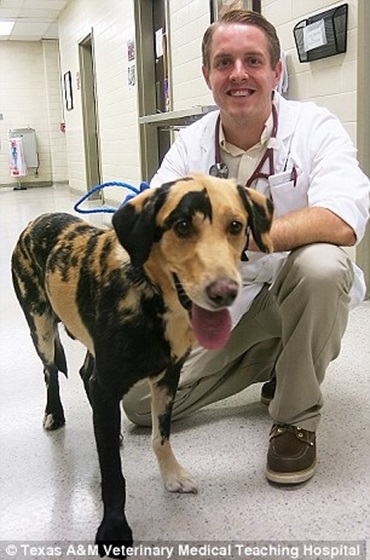
A good Lab is a good Lab, no matter the color
Now you know about Labrador coat colors, both the colors you see and the ones that are hidden. You know Labradors come in black, yellow, or chocolate and sometimes have hidden copies of those colors.
How many unique crosses do you think there are, taking into account the seen and unseen colors? For example, you could breed a black Lab with hidden chocolate to a black Lab with hidden yellow. Or a black Lab with hidden yellow to a yellow Lab with hidden chocolate. Or two black Labs and neither has hidden yellow or chocolate. So these are three to start off, but there are a lot more.
Hint #1: Use the color shorthand. For example, “EEBB” for black with no hidden color. Or “EEBb” for black carrying hidden chocolate.
Hint #2: Be methodical. List all the black variations. Then pair the first variation with each of the variations. Then pair the second variation with each of the variations. And so on.
Frequently asked questions:
Can two black labs have yellow puppies?
Yes, but only if both parents carry the hidden yellow gene.
What color Labradors can you get?
Labrador coat colors are black, yellow, or chocolate. Black is wholly black, although it may have a small white spot on it’s chest. Yellow can range from nearly white to a rich orangish red. Chocolates are supposed to be, well, chocolate.
Is there a coat color test for Labrador Retrievers?
Yes, several laboratories can test for color. I use DDC because they are helpful, with a fast turnaround time, and are less expensive than some other labs.
Does Labrador coat color matter?
For a pet, no, it doesn’t matter. However if you plan to compete in the show ring, it can matter if the dog has any mismarks. Also the so-called “Silver Labs” tend to have color dilution alopecia which is a genetic condition affecting their skin and coat.
Do different color Labradors have different personalities?
Years ago there were rumors that chocolate Labs were hyperactive, yellows were lazy, and blacks were the best of all. Having had many Labs over the years, I’ve never seen temperament connected to coat color.
Which color of Labrador is the best to buy?
It depends on your preference. Some people say chocolate Labs don’t live as long, but my chocolate boy lived to 17. I know someone whose black Lab lived to 18.
Do white Labrador retrievers exist?
Not really. The “polar bear white” Labs that some people advertise are really just a yellow dog with very light pigment.
Should I get a silver Lab?
I would advise against it. They’re not purebred Labradors, but have been mixed with Weimaraner. Plus they’re prone to color dilution alopecia and are often more expensive than purebred Labs.
Genetic terms
Genes
The basic unit of inheritance. Genes are passed from parents to children and contain the information needed to specify physical and biological traits.
Alleles
Different variants of genes. Each parent provides one allele of a pair.
Chromosomes
Thread-like strands that contain hundreds, or even thousands, of genes
Dominant vs Recessive
If one allele in a pair always makes a trait appear, that allele is called “dominant.” The other allele is recessive. For example, a Lab might be black (a dominant trait) and carry an unseen chocolate allele (a recessive trait). The dominant allele is shown as a capital litter and the recessive allele is shown as a lower-case letter, for example Bb.
Genotype
The entire set of genetic material of a dog (or cat, person, etc).
Phenotype
The physical characteristics of something living, especially those characteristics that can be seen
Homozygous
The same alleles of a gene from both the parents (written as two capital letters, such as BB)
Heterozygous
Different alleles of a gene from the two parents (for example, Bb)
A costume contest for pets got me thinking about what Halloween costumes for dogs might be available. I also needed coordinating costumes as my dogs, Chip, Tory and Arwen, would all be participating.
And, rather than buying something ready-made, I wanted to make the dog Halloween costumes myself.
Come along with me to learn about my thought process, dog costume ideas, what supplies I bought, and how I made the costumes.
The 3 Musketeers started it all
All for one, one for all!
Designing the costumes was interesting because they had to be instantly recognizable, but my dogs also had to walk in them. After a quick Google image search, I decided on hats with feather plumes and the signature musketeer tunic. I also bought plastic swords for all of them, but could only convince one dog that they weren’t chew toys.
I started by measuring each dog from just below their collar to just above their front feet. Then I measured in back from just below their collar to the base of their tail. I also measured across their chests, from the outside of one leg to the outside of the other leg. And finally I measured across their chest and shoulders and back around to the front. This measurement, less across the chest, gave me the top of the cape measurement. (Just in case, I added 2 inches.)
Next was calculating the amount of fabric needed and making a list of supplies.
After cutting out and test fitting, I stitched together the tunic and cape at the top corners. Then I glued gold braid around the edges of the fabric. I saved painting the crosses for last so I didn’t risk smearing the paint.
Next I reshaped the hats using moist heat and lots of patience. I attached the white feathers with a couple spots of glue. And finally I added some thin elastic as chin straps to keep the hats on their heads.
Luckily Labs don’t mind playing silly games like dress up! They did spectacularly and even won the costume contest at the local Labrador club.
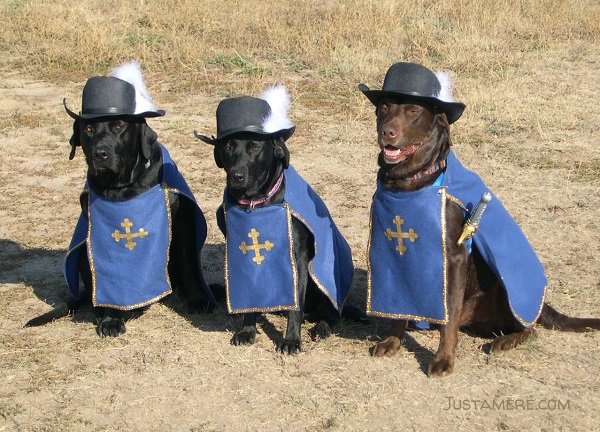
Supplies
- blue felt fabric
- gold braid trim
- gold fabric paint
- 3 black cowboy hats
- 3 fluffy white feathers
- 3 plastic swords
- hot glue gun and glue sticks
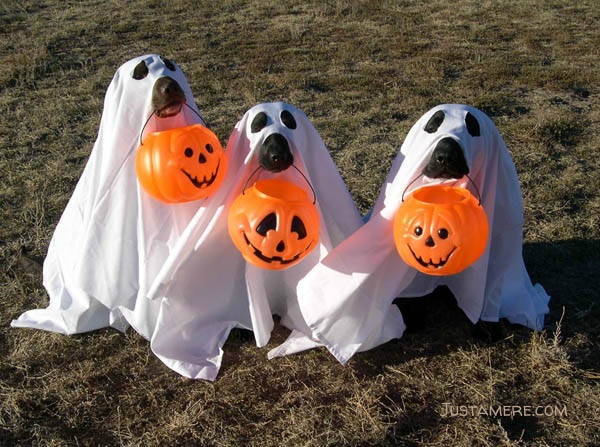
Supplies:
- 3 white flat sheets
- 3 plastic jack-o-lanterns
Trick or treating ghosts
What could be more iconic than ghosts on Halloween? Except these ghosts had four legs!
That year was a test of their obedience skills. They had to sit with sheets over their heads and carry plastic jack-o-lantern buckets.
Buying three flat sheets and three jack-o-lanterns was the easy part.
Next came draping a sheet over each dog and determining the best place to cut holes. It took some trial and error – with each dog – to find the perfect place and sizes for the holes. I made sure to start with small holes and test fitted before making the holes bigger.
My dogs were all taught to fetch on command, but it took a bit to convince them that fetch also applied to the thin bucket handles. After all, they were used to retrieving birds or a bumper.
Then they had to learn that I wanted them to sit, with a sheet draped over them, AND hold the bucket. And they had to do it at the same time and for long enough to get pictures.
They did it and got plenty of treats!
Four-legged duck hunters
The next year had to be something simple because I didn’t have time to make elaborate costumes for Halloween. So I dug out some hunting clothes – ball caps, camo shirts, duck calls, whistles, etc.
After getting them all dressed, something just didn’t look right. Off I went to the nearest thrift store where I found three pairs of kid’s pants in tan and green.
Getting all three dogs to wear the hats, shirts, whistles and duck calls was easy. Putting pants on them took a bit more work. =D
When they were dressed and sitting attentively, I took the picture. And just then the shotgun fell over. No, it wasn’t loaded, but it got their attention. As they moved, hats fell off, pant cuffs were stepped on and general mayhem ensued.
Good thing that one photo turn out so well!

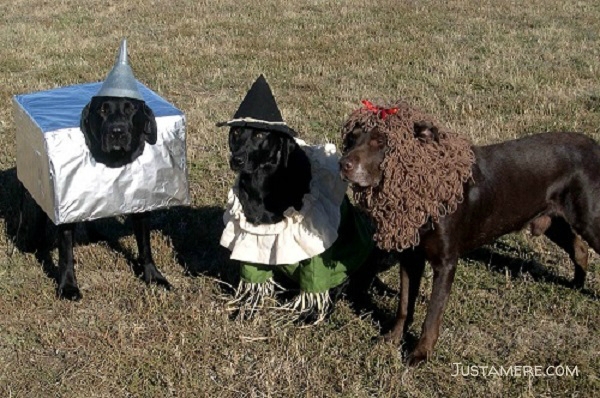
Follow the yellow brick road
As Halloween drew nearer, I was trying to come up with a theme so each dog would have a unique costume but be recognizable as a trio. Pairs are easy, threesomes take more work!
The Tin Man costume
I found a box as long as my dog from chest to tail. Next I taped the flaps to the inside and flipped the box over. Then I cut a large hole with about half on the front and half on the top. The hole should be just big enough for the dog’s head to slip through.
I tried painting the box silver, but it didn’t look metallic enough. Instead, I covered it in aluminum foil. It looked better, but made a crinkly noise when moved. It took some patience and a few practice sessions before Tory felt comfortable wearing the box.
I used an old metal funnel for the hat. After drilling a couple holes near the top of the funnel, I added some thin elastic to go under his chin.
Good thing he had learned the Stand for Exam obedience exercise!
The Scarecrow costume
Arwen‘s Scarecrow costume took some sewing and several fittings to come close to fitting her. I started with a shirt pattern, but made the front narrower and the back wider. In hindsight, using a plain green t-shirt would have been easier. For the collar, I stitched a piece of creamy white fabric into a circle and added elastic near the top.
For the hat, I glued black felt into a cone shape. The wide end needed to be about the width of the dog’s head. Next I cut a circle that was about 2″ wider than the base of the cone. I glued it to the cone and cut out the center portion. Thin black elastic kept the hat in place. I also glued short bits of raffia to the brim.
Just before taking the photo, I tucked some raffia into the sleeves.
The Cowardly Lion costume
What took the longest to make was Chip‘s lion mane. I took a measurement from about the middle of his forehead to the top of his shoulder blades. Then I cut a piece of stretchy fabric to that length and sewed it into a tube. One end was a snug fit around his head while the other end fit around his shoulders. During the final test fit, I marked around the top of each ear. After removing the tube, I cut holes for his ears.
For the mane, I wrapped yarn around three fingers and tied one end tightly before cutting the bundle loose. I used a whole skein of yarn making these bundles. Then starting at the narrow end of the tube, I sewed each bundle to the stretchy fabric. To finish, I tied the ribbon in a bow and stitched it in place between the ear openings.
I’m not sure if they were starting to enjoy Halloween dress up or if they were just resigned to my shenanigans.
Old west characters
In early October the next year I found myself wandering the Halloween aisle in the local store. I was trying to come up with another trio of costumes. Looking at this and that, I found a red bustier (corset) that was sized for a child. There were also cowboy hats and six guns nearby. Hmmm.
Arwen’s costume was pretty easy. Tie some red ribbon in a bow and attach to the wig. Check. Lace her up in the bustier. Check. Add a table prop to help her sit up and show off her costume. Check!
The black-wearing outlaw took a little more work. I added a thin piece of elastic to hold his hat in place. Then cut the black fabric, folded it into a triangle and tied it around his neck. Added his belt and holsters and he was ready.
The sheriff’s outfit took a little more work, but not too much. I added a thin piece of elastic to hold his hat in place. Then I cut and sewed the tan fabric into a tunic. The belt with holster held the tunic closed. Finishing touches were the red bandana and the sheriff’s badge.
Tory and Chip were perfect in their roles as the outlaw and the sleepy sheriff. Arwen was not pleased though. I don’t think she liked having to wear a girly outfit with a wig AND sit up. She would have made a good outlaw, but for this year she was the dance hall gal.
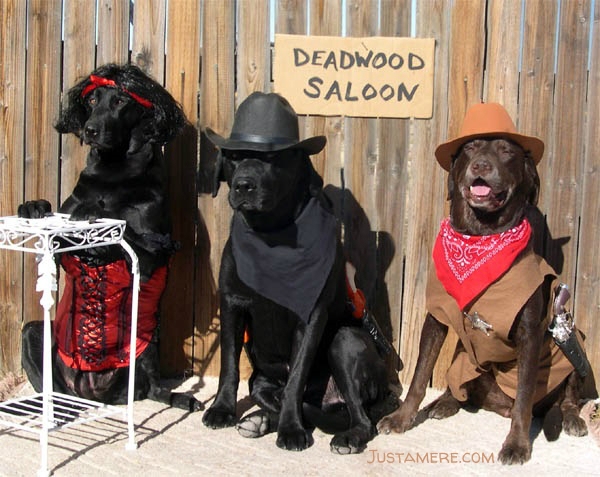
Supplies:
- red bustier
- black wig
- 8″ piece of red ribbon
- a black cowboy hat
- a brown cowboy hat
- two sets of six-guns with belts and holsters
- a sheriff’s badge
- a red bandana
- fabric pieces in black and tan
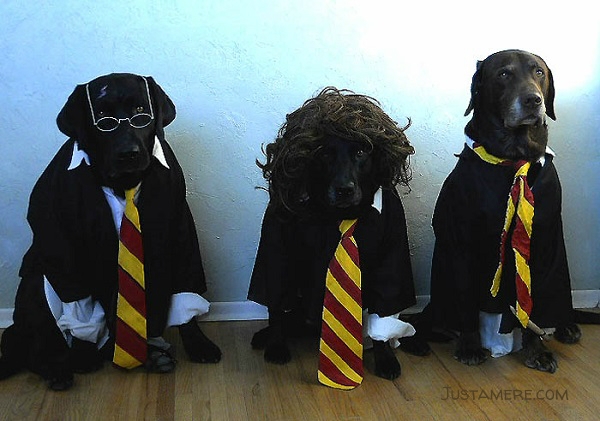
Supplies:
- 3 white shirts
- 3 men’s ties
- red and yellow fabric paint
- black witch’s hat
- 2 pairs of reading glasses
- white chalk
- white paint
- black fabric
You’re a wizard Harry
The next year I decided to show them that dressing up isn’t all that bad. So I joined them.
Another trio – Harry, Hermione and Ron – plus one – Professor McGonagall.
Starting with the ties, I turned them into Gryffindor ties with SEVERAL coats of the red and yellow paint. Notice how one turned out a bit wrinkly? That was Ron’s tie. His shirt didn’t tuck in well either. I also sewed the black fabric into robes for all four of us.
Got us all dressed with white shirts, plus the ties and robes.
Next was sweet talking Tory into wearing glasses and Arwen into wearing the wig again. The glasses didn’t show up well on a black dog, so I took the lenses out and painted the glasses white. Much better!
I added a lightning bolt on Tory’s forehead with white chalk and told them to say ‘cheese’! And, yes, they smiled! They also got to go to the Halloween party and schmooze everyone for tasty treats.
Tip: Start your shopping at local thrift stores. I bought all the shirts and ties for less than $10. The stores will usually also have lots of ready-made costumes for sale.
I’d just as soon kiss a wookiee
The next Halloween became an homage to the Star Wars movies, but which three characters should it be? Darth Vader, of course. And when you have bad, you need good.
Should it be Luke, Leia or Yoda? Costume-wise, Luke was boring and I didn’t want to try hanging cinnamon rolls on my dog’s head, so Yoda was it. And, of course, you need the iconic R2D2.
Next was figuring out which parts of the characters were needed for people to recognize the costumes: Yoda’s ears and light saber, Darth’s light saber, cape, chest plate and helmet (well, most of it because the mask wouldn’t fit) and R2D2’s shape and coloring.
Do you have any idea how long it takes to paint a bowl and fabric to look like R2D2? And that was just the start.
Darth’s helmet and Yoda’s ears both took several fittings, plenty of sewing and LOTS of interfacing to make them stiff enough to look right.
Then more sewing to make Yoda’s robe plus painting Darth’s chest plate and two light sabres.
Luckily last year’s Gryffindor robe worked great for Darth too.
It was worth it though because this was one of the most popular sets of costumes. They were dubbed R2-Dog2, Dog Vader and Yo Dawg.
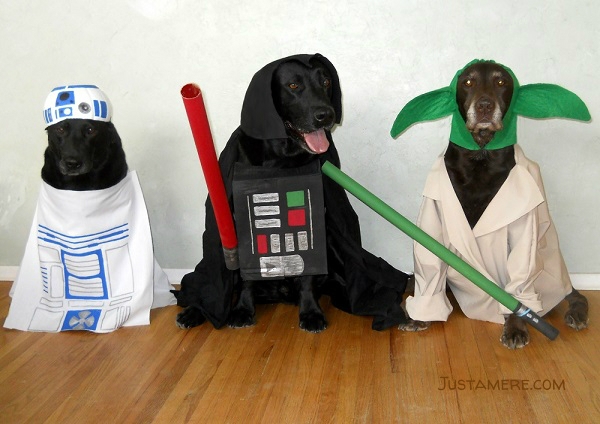
Supplies:
- a white, plastic bowl
- white fabric
- acrylic paint in white,blue, green, red, silver and black
- a cardboard box about the size of a ream of copy paper
- fabric pieces in black, green and light tan
- fusible interfacing
- two cardboard cores from Christmas wrapping paper

Supplies:
- silver acrylic paint
- black fabric (I repurposed the Gryffindor robes)
- white shirts (I repurposed the shirts too)
- 3 black hats with broad brims
- red satin fabric
All of us has an El Guapo to face
If you can’t tell, I choose characters that are usually a bit over the top to make interesting costumes. So it should be no surprise that Chevy Chase, Martin Short and Steve Martin made an appearance on the next Halloween as the Three Amigos!
With a lot of patience and some silver paint, the Gryffindor robes became sparkly jackets. The white shirts were reused. I also painted the hats. Then a bit of sewing turned the red fabric into ties and cumberbunds.
It’s amazing how detailed the real costumes were and I tried hard to replicate the look.
I think Arwen finally liked her costume.
Down the rabbit hole
Liking her costume was short-lived. The next year I put Arwen in a pink Cheshire cat costume and had her lay down on a bench. If looks could kill…
For the hat, I glued green construction paper into a tube shape with the top wider than the bottom. The bottom needed to be about the width of the dog’s head. I cut two circles – one for the brim and one for the top. The brim should be about 2-3 inches wider than the bottom of the tube. I cut the top piece a little big and cut off the excess after it was glued to the tube.
To finish the hat, I added some green ribbon around the base of the hat. I made a card with “10/6” written on it and tucked the card in the band. Thin black elastic under his chin kept the hat in place.
Adding a wig, jacket and green tie completed the Mad Hatter’s costume.
Making a White Rabbit costume required some creativity. I nixed the idea of painting my black Lab white and instead used features to hint at his identity. I made rabbit ears out of white and black construction paper with light gauge wire glued inside. The wire made the ears bendable and also attached the ears to a plastic headband. Next I repurposed a tie from the Three Amigos costume and added a matching jacket. The white rabbit’s large pocket watch was made by painting a whipped topping container lid.
There was a fourth player too, but it wasn’t me this year. In the story, there is a Dormouse who pops out of a teapot. I tried James the rat as a stand-in, but he never got his cue right.
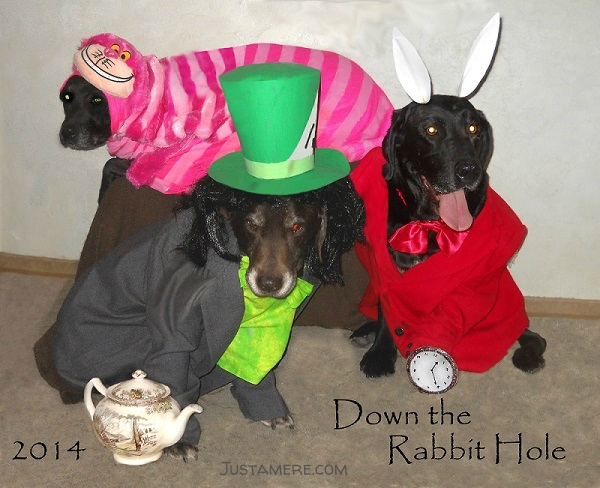
Supplies:
- Cheshire cat costume from a yard sale
- 2 jackets repurposed from my closet
- red tie remade from the Three Amigos costumes
- white, black, and green construction paper for the hat and ears
- acrylic paint in white, black, gold
- black Sharpie-type pen
- about 12 inches of 1 inch wide green ribbon for hat band
- thin piece of elastic for the hat
- a small piece of green fabric for the tie
- wig
- about 36 inches of light-gauge wire for rabbit ears
- plastic headband for the ears
- plastic lid from a whipped topping container
- teapot
- hot glue and glue gun
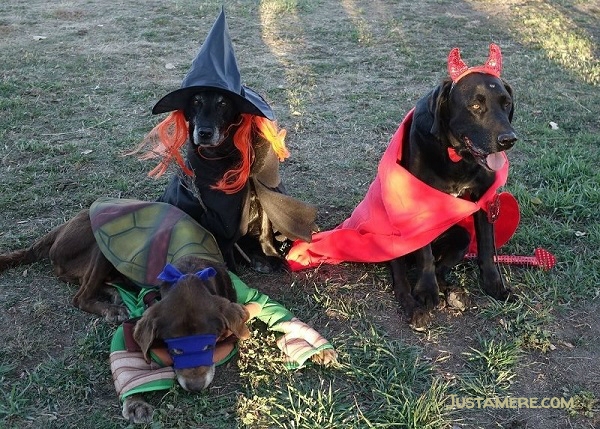
Kids costumes for dogs
By Halloween 2015 we were winding down. Chip was nearly 17 and slept a lot. Tory had been diagnosed with cancer. And I was heart sick. I felt I needed to do one more Halloween photo, but it would have to be simple.
Off to the store again where I found some ready-made costumes – a devil, a witch and a ninja turtle.
I lost Tory just a few days later and Chip in December.
Easy to make deer costume
Although 13 years old, Arwen was still willing so back to the store I went. For her first solo, she was a deer. A trophy deer.
I cut a big piece of cardboard into a shield shape with a hole in the middle just big enough for her head. Then I added some ‘wood grain’ with a Sharpie.
Next I cut the felt into some oval shapes with the brown felt pieces slightly larger. For a Labrador these pieces were about 8 inches long and 3-4 inches wide. I layered the tan inside the brown felt then rolled and glued one end to make an ear. I repeated the process to make the other ear.
Using some wire, I attached the ears and some twigs to the headband. To introduce her to the cardboard, I let her sniff it and then put it on her head. Note: the cardboard only went over her face. I made the hole small enough so the cardboard would not slip over her ears and down her neck.
With a little persuasion, Arwen sat with this contraption on her head while I took pictures.
Isn’t she cute?
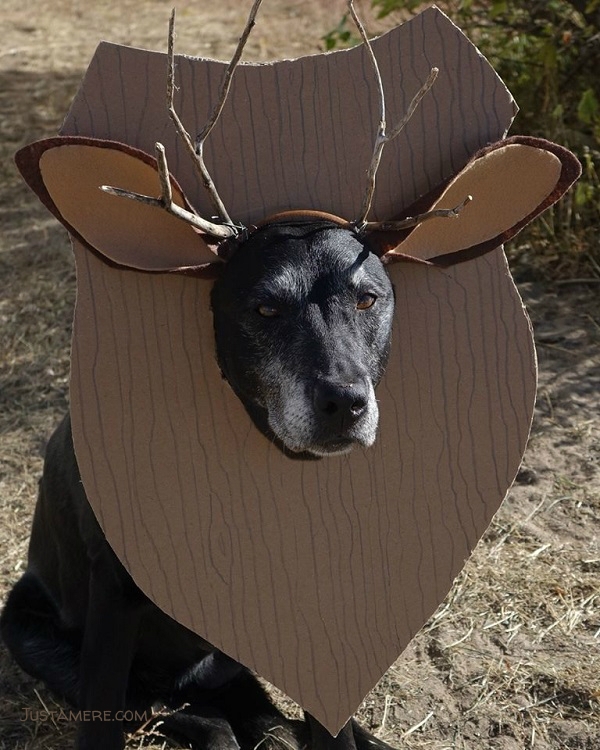
Supplies:
- large piece of sturdy cardboard
- Sharpie pen
- brown and tan felt
- girl’s plastic headband
- light gauge wire
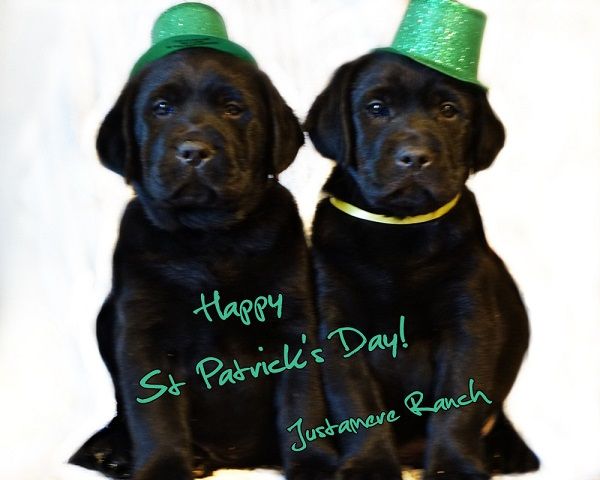
Supplies:
- small party hats
- thin black elastic
- a friend willing to help
Simple costume for St Paddy’s day
After eleven years of Halloween costumes, it was a time of change. More dogs went to the Bridge, but eventually young dogs “volunteered” to carry on the tradition.
In the spring of 2018 I had a litter of puppies who were ready for their 7-week evaluations. A good friend came over, we evaluated puppies, took lots of pictures and decided to give costuming another try.
I already had a bag of small, sparkly green party favor hats. After poking small holes on each side of the hats, I threaded thin black elastic to help hold them on the puppies’ heads. Luckily the puppies had run off some energy, but weren’t quite ready for a nap. Perfect!
We put two puppies on a table as my friend stood to the side to hold them still. Checking the pictures afterward, we saw the background was just too busy. Bless her heart! She let me throw a white blanket over her head while she stood behind the puppies, keeping one hand on each puppy’s hip.
It took a little Photoshopping to blur the background and add a St. Patrick’s Day wish, but the final photo was worth the effort!
Which witch is which?
In 2019 I was finally ready to try Halloween costumes again. Tisket and Wynk were both obedience trained, so although skeptical, they were willing to sit as I fussed.
For the hats, I rolled some black construction paper into cones with glue to hold it. Then I cut a couple donut shapes for the brims and glued those to the base of the cones. After adding some black elastic to keep the hats in place, they were done. But they were kinda boring. Hmmm. Hot glue gun to the rescue! I added several stripes of glue to the cones and brim to give the hats a little sparkle.
The broomsticks were fairly easy, although a bit messy. I wound raffia into two bundles about 10 inches long and wrapped rubber bands near one end. After sticking the dowels into that end, I cut apart the other end and skrunched until it looked right. To hide the rubber bands, I wrapped some raffia over them and tacked it in place with hot glue.
To solve the problem of no hands to hold the broomsticks, I used more black elastic. I cut two pieces about 8 inches long for each dog. Then tied the ends in a knot that was tight enough to hold the broomstick, but not too tight. I slid them on each dog’s leg and slid the broomstick along the leg and under the elastic.
I hoped to take the photos in front of some small trees that had already lost their leaves, but it was too cold and windy. Back inside, I taped a gray sheet on the wall as a background and started taking pictures. But after checking, I decided the background just wasn’t right.
Photoshop to the rescue. I removed the background and made it transparent. Checking Pixabay images I found a colorful sunset that looked great, added it with a bit of text and my signature. Done!
What do you think of my pretty witches?
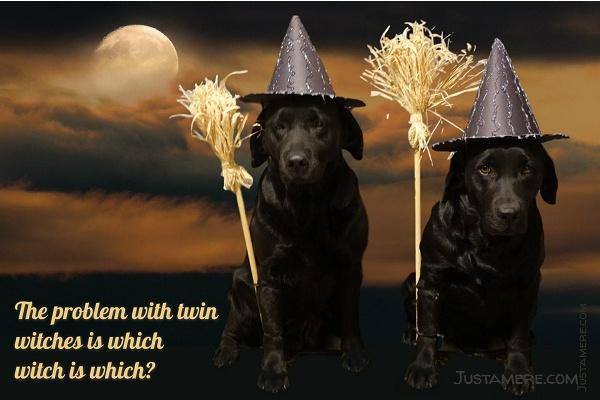
Supplies:
- black construction paper
- thin black elastic
- hot glue gun and glue
- 2-1/2 inch dowels
- raffia ribbon
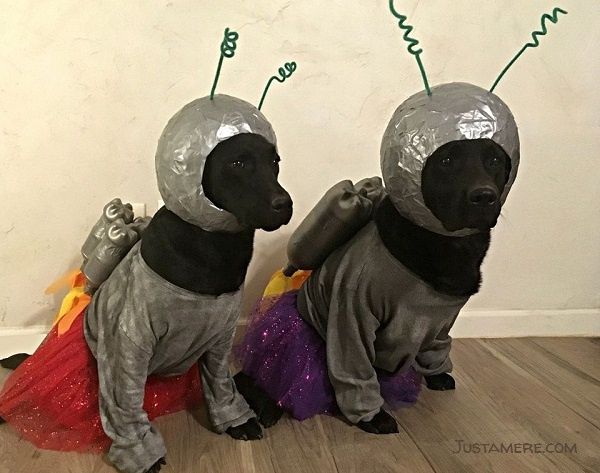
Supplies:
- two stretchy pullover shirts
- yellow and orange tissue paper
- a bag of big pipe cleaners
- a bag of blow up balloons
- lots of duct tape
- several empty soda bottles
- gray spray paint
- about 6 inches of Velcro
- two really cute tutus in sparkly red and purple
Fun space cadets costumes
I had an idea I wanted to try for Halloween, but it’s a good thing I started early.
First task was testing the concept. I blew up a round balloon and covered it with criss-crossing duct tape, leaving a large hole on one side. It took a LOT of tape. When I thought it had enough tape to hold it’s shape, I popped the balloon. Nope, it needed more tape.
But before adding more tape, I decided to test fit it. Splash was willing, but thought I was certifiable. I made a few modifications and continued adding tape. I also added pipe cleaner antennas. Then duplicated the process for Sketch’s helmet.
Next were the power packs. I had a few plastic soda bottles and painted them silver. While I was at it, I also painted both stretchy shirts. When the bottles were dry, I taped them together. I added Velcro to the bottles and backs of the shirts. Then I added some tissue paper to the ends of the bottles to simulate flames.
Now the test. Would they wear all this stuff AND sit still? Obedience training sure helps, but it was hilarious watching them step on the tutus.
Introducing Space Cadets Sketch and Splash from the Department of Intergalactic Security and Information (DIS-Info.com) ready for service.
By the way, their great grandmama Arwen would be proud!
Christmas party costumes
For Christmas 2020, Sketch, Splash and Wynk got their party on!
Starting with the easy outfit, I added a piece of black elastic to the Santa hat to hold it on. After test fitting, I also added a stitch to hold the pompom in the right place.
Next up was Sketch’s Christmas tree. I cut two pieces of the green felt into a Christmas tree shape. Using an old clothes hanger, I cut and shaped it into an upside down V shape. With the hanger ends sticking out of the bottom about an inch, I hot glued the hanger to the felt. I bent the ends and left them long for support at the back of the tree. Then I glued the front and back together and to the hanger. I added some small decorations. It did take a bit of tweaking to keep the tree from falling over.
Splash’s antlers were made similarly to the tree. I made the red nose from a circle of red felt stuffed with cotton balls. It weighed nothing, but Splash thought she should hold it in her mouth instead of balancing it on her nose. Tiny black elastic to the rescue.
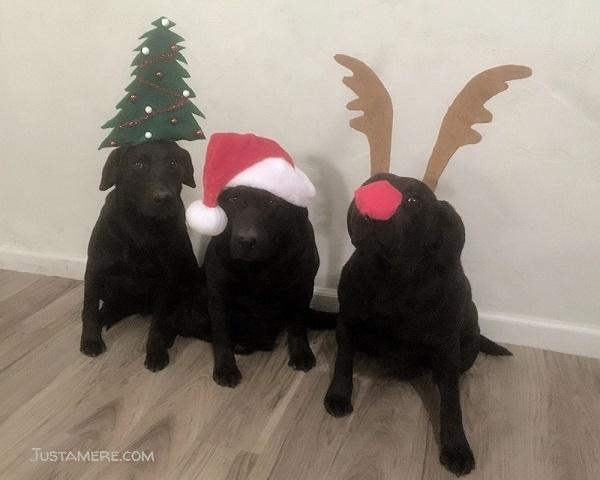
Supplies:
- Santa hat
- green, tan and red felt
- 2 plastic headbands
- tiny Christmas decorations
- glue gun and glue sticks
- thin black elastic
- a couple of old wire hangers
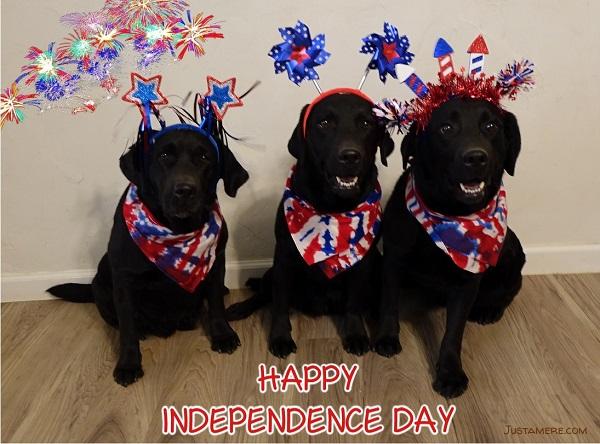
Supplies:
- 3 red, white and blue bandanas
- 3 decorative headbands
- fireworks sticker
Super simple costumes for July 4th
Costumes for Independence Day celebrations were a snap! Bandanas, decorated headbands and a small fireworks sticker for the wall was all it took.
Wynk, Sketch and Splash really got in the spirit this time!
Inexpensive skeleton for Halloween
This Halloween was supposed to be two canine skeletons. Alas, there was only time enough for one.
I tried white chalk, but it didn’t cover well enough on a black dog. Instead I used nearly a bottle of white acrylic paint. It took quite awhile to paint and Splash needed several breaks. She was carefully supervised so she didn’t spread the paint around the house.
Even a first year veterinary student would probably laugh at the bone placement, but I think she turned out cute. Especially when Splash thought she saw a “ghost” popping out from behind the couch.
Splash got to model her costume for another day, then needed a bath to look like herself again.
Tip: Try colored chalk or paint if your dog isn’t black.
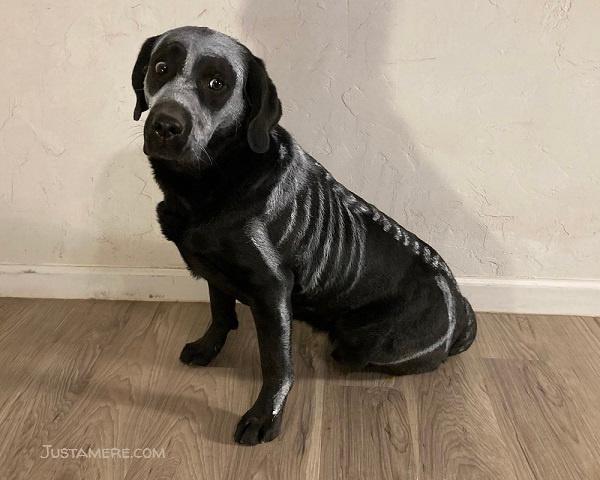
Supplies:
- white chalk or acrylic (washable) paint
- dog skeleton image for reference
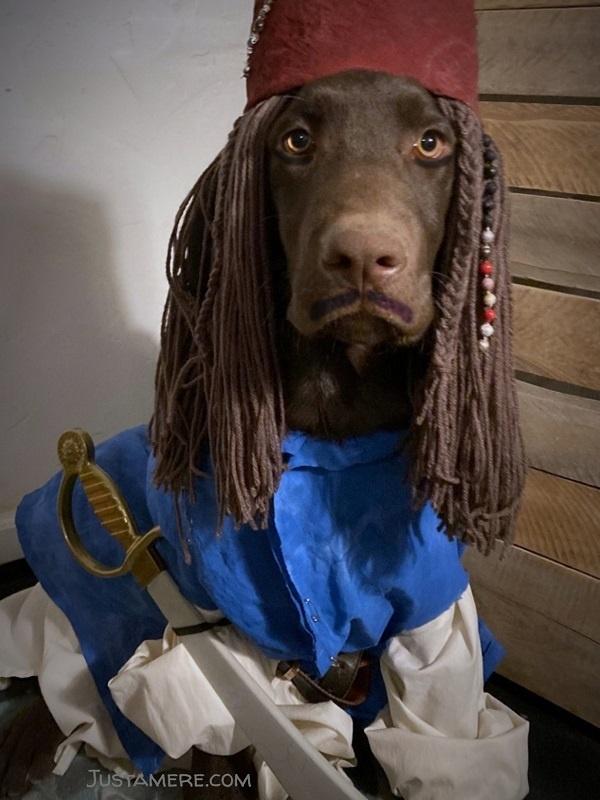
Supplies:
- blue acrylic paint
- skein of brown yarn
- 2 small strings of craft beads
- red bandana
- pieces of fabric on sale
- toy sword
Drink up me hearties, yo ho!
Halloween 2022 brought a new player to the lineup. This is 5-month old Boo, a chocolate Lab. I think he was born for the limelight!
To prepare, I looked through many images to help me decide what to get to capture the essence of Cap’n Jack Sparrow.
After loading up on supplies, the first task was cutting and gluing the fabric into a vest shape. It needed a color boost and a bit of blue craft paint worked just fine.
Next was cutting yarn into 24 inch pieces, folding them in half and gluing together into clumps. I also braided a couple pieces of yarn.
In the movies, Cap’n Jack often wears a dirty red bandana around his head. However the difference in anatomy between people and dogs presented a bit of a problem. To solve it, I first tied the bandana like it was on a person’s head. Next I glued all the yarn clumps, plus the braid and a string of beads to the inside of the bandana. I also added a string of beads to the top of the bandana.
It wound up looking like a fez, but at least it didn’t need elastic to stay put.
Next we had some rehearsals.
Wear the hat and wig while sitting? Check.
Wear the blue vest and a white shirt while sitting? Check.
Wear all of it plus the sword while sitting? Check.
Added a smudge of mascara under his eyes and on his lip. AND WE ARE READY!
Boo did a great job as the dashing, yet goofy, Cap’n Jack.
My what big teeth you have!
Boo is back; this time with momma Wynk.
I started her costume by cutting a hole big enough for her head in the closed end of the pillow case. Then I folded the corners over and tacked them down to make the shoulders look more realistic. (Note: I realized later this wasn’t necessary as they were covered by the cape.)
Next I pulled the pillow case over her head and marked where I needed holes for her front legs. I started small when cutting the holes and gradually made them bigger. A tape measure might have helped, but this way seemed easier for me.
Then I cut two rectangles out of the black fabric – about 9 inches wide and 15 inches long. They needed to be long enough to cover from her shoulders to her waist. And wide enough to cover from the edge of her chest and around her side. I decided not to take it all the way around her back as that would be covered by the cape.
I also cut four pieces of black fabric about 1/2 inch by 12 inches to criss cross her chest. Black ribbon would also work.
Placing the black rectangles on the front of the pillow case, I left about 7 inches open in the middle. I attached the criss crosses in the middle and the black rectangles on the sides, using the glue gun.
Turning it inside out, I cut the black fabric where it overlapped the leg holes. Time to test fit!
Next up was making the red skirt. I cut the red fabric at 22 inches long and glued the selvages together. Then I turned over about an inch at the top and glued the edge to make a tube. After measuring around her waist, I cut some elastic about 2 inches shorter. I slid the elastic through the tube, pulled it snug and tied it in a knot.
For the cape, I cut the fabric about 40 inches long. After folding it in half, selvage to selvage, I laid it out on the table. I drew a shallow curve along the top edge using some chalk. Next I cut and glued together the cut edges.
For the ribbon, I cut the leftover fabric about 1.5 inches wide and selvage to selvage. I wrapped this around Wynk’s neck and tied a bow to hold the cape on.
Boo’s costume was much easier. First a quick trip to a thrift store for an old-fashioned nightgown and reading glasses. Then I cut about 8 inches off the bottom of the nightgown and slip-stitched the cut edge. I carefully pulled the thread to make a floppy night cap.
As dusk was descending, I took Wynk and Boo out to the edge of the woods. I dressed Wynk first and fluffed up the cape and skirt. Boo’s costume was simple and quick. Snapped a few photos and done!
What costume(s) should we try next year? Use the contact form to let me know your ideas.
Note: Because these costumes probably wouldn’t be used again, I cut corners. I glued seams instead of stitching and left raw edges instead of hemming.
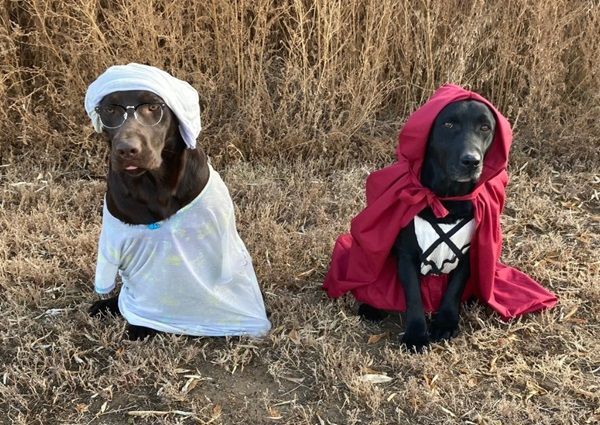
Supplies:
- old, white pillowcase
- black fabric remnant
- 2 yards red fabric
- 24 inches white lace, approximately 2 inches wide
- thread
- thrift store nightgown
- eye glasses
- glue gun and glue
This post was originally published on October 31, 2019. Edited and updated with new content on April 9, 2024.
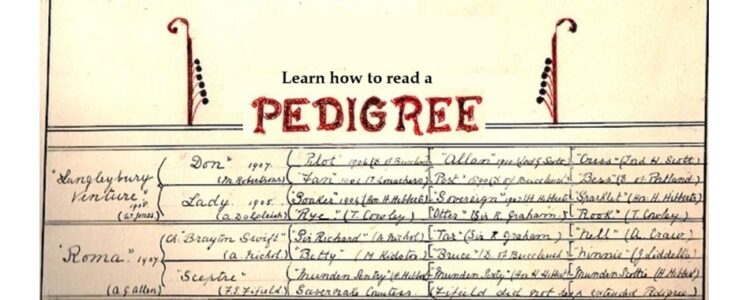
What are dog pedigrees?
Dog pedigrees are essentially family trees. They start with one dog, then his parents, then grandparents, and then great grandparents. It can continue further, but let’s start with just three generations of ancestors.
In other words, it shows the relationship between a dog of one generation and his ancestors.
Here is a simple example of Peter of Faskally’s pedigree. His name is on the left. The two slightly indented names are his parents – Waterdale Gamester and Birkhill Juliet. Indented further are his four grandparents – Spratt, Twinkle, Nith, and Susan. His eight great grandparents are indented even further.
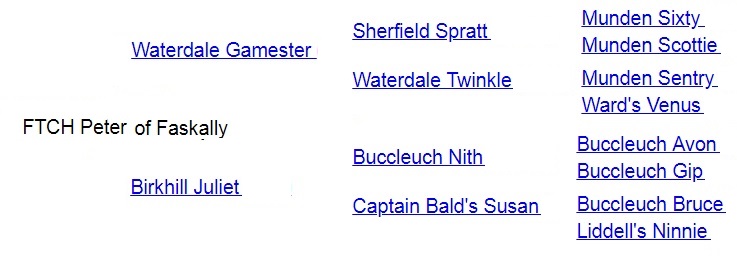
For each pair, the male is on top, the female below. So Waterdale Gamester is Peter’s father and Birkhill Juliet is Peter’s mother.
In the next generation, Sprat is Gamester’s father and Twinkle is Gamester’s mother. Nith is Juliet’s father and Susan is Juliet’s mother.
Sometimes the main dog’s name – in this case, Peter – will be at the top of the pedigree instead of on the left. Often there will also be information about him such as date of birth, color, breeder, and owner.
Most pedigrees only include direct ancestors and not siblings, as it shows in Peter’s pedigree.
Sometimes pedigrees show more generations, but each generation back doubles the number of dogs in the previous generation. It doesn’t take long to become unwieldy.
How to read a pedigree chart
A pedigree chart is another type of pedigree this time based on a grid. The top portion is used for the dog’s information and possibly a small image.
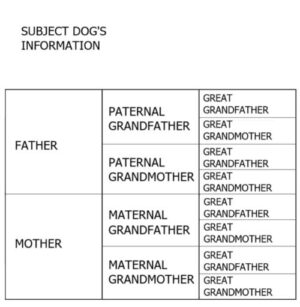
The first column has 2 rows for the parents. The father is always in the top row and the mother in the bottom row. The second column is for the grandparents with the first two rows for the father’s parents and the last two rows for the mother’s parents.
The third column is for the great grandparents and is divided into eight rows. The first two rows are for the paternal grandfather’s parents. The next two rows are for the paternal grandmother’s parents. The final four rows are like above, but are for the mother’s grand parents.
If you have a copy of Microsoft Excel or another spreadsheet program, it’s easy to set up the rows and columns. Then it’s just a matter of filling in the generations. Just refer back to your source documentation to make sure everything is correct
More information in dog pedigrees
Most pedigrees include additional information about the dogs listed. Usually they show each dog’s color and date of birth. Often they show the registration number and titles of each dog. Sometimes they show even more information such as the breeder’s name and sometimes their address.
Some pedigrees will show most dogs’ names in black type and titled dogs in red. AKC abbreviations you might see include:
CH = Show Champion
GCH = Show Grand Champion
FC = Field Champion
MACH = Master Agility Champion
OTCH = Obedience Trial Champion
CDX = Companion Dog Excellent
JH = Junior Hunter
NAJ = Novice Agility Jumper
RE = Rally Excellent
TKN = Novice Trick Dog
Other clubs and organizations, such as the United Kennel Club, Hunting Retriever Club, and Super Retriever Series offer their own titles.
Another pedigree variation
A pedigree analysis chart is another type of pedigree. It’s usually used to study heredity traits and disorders. However it can be used to show descendants of a dog or dogs.
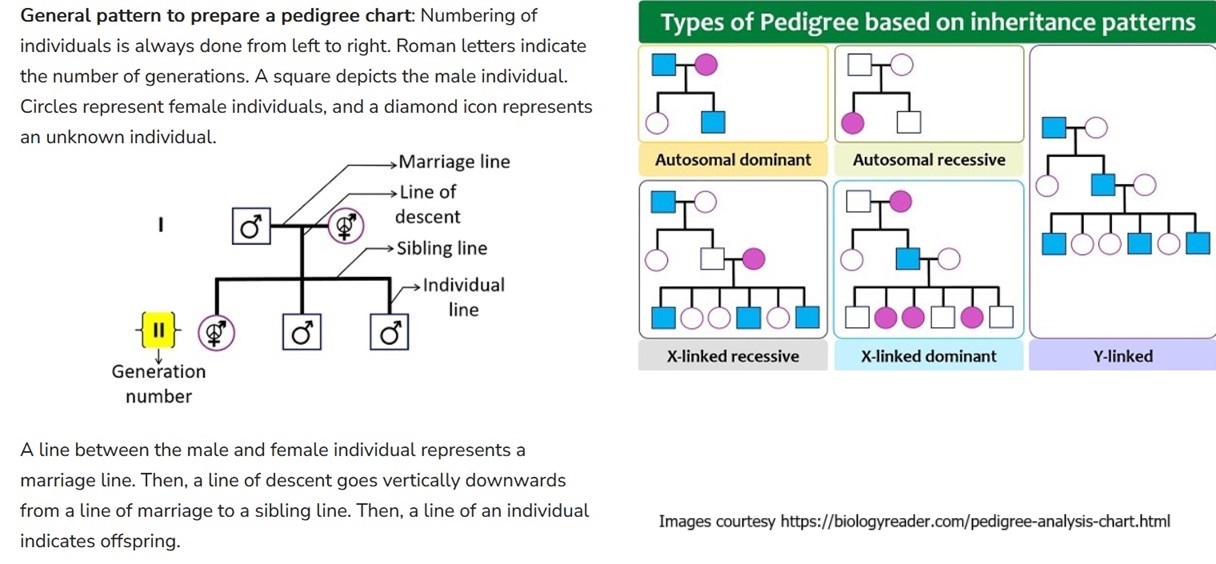
This chart starts with a father and mother and shows their offspring linked downward. Symbols are used including squares for males and circles for females with a line linking a breeding pair.
A horizontal line links the offspring together with a link from the parents joining the horizontal line.
These charts often follow only one line of descent. For example, it will have a breeding pair with their offspring below. The next generation will usually only show the offspring of one son or daughter.
This type of chart is used to track inherited traits. For example, it might track coat color with a black father shown by a black square and a yellow mother shown by a yellow circle. If the father has a hidden yellow gene we’d add a yellow dot in his black square.
Their puppies would be shown linked below the parents. Each would be colored either yellow or black with a yellow dot.
Why add a yellow dot? All the puppies got a yellow gene from the mother. While the puppies got a black gene or a yellow gene from the father. The puppies that got the black gene will be black, but also carry a hidden yellow gene from the mother. Thus the dot.
Let’s take a look at a few more examples
The first example is a page from a pedigree book. It shows five generations with some of the best bloodlines. The dog was bred by Sandylands, a very influential English kennel. He finished his show championship and was a popular stud dog. Several of my dogs descend from him!
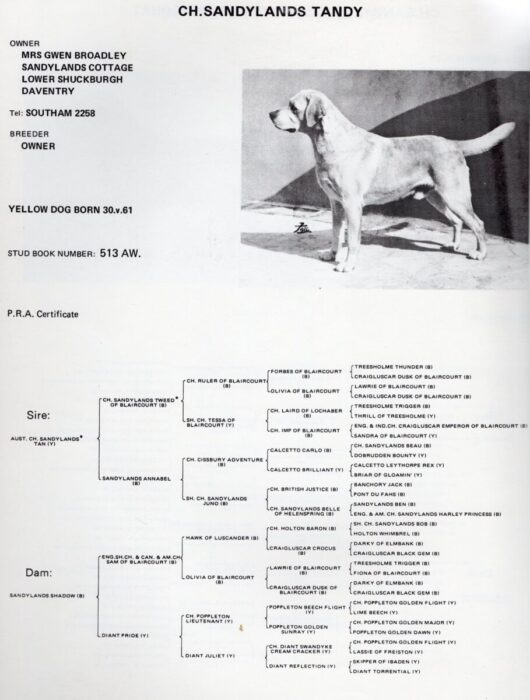
Pitch was another influential dog. She had a dual champion granddaughter and at least two show champion kids. She’s also line-bred on some very influential dogs. See if you can find the brothers in her pedigree. And, yes, she’s in the pedigrees of several of my Labs.

Now that you know how to read a pedigree, you can create a pedigree for your dog. Or you can buy one at AKC if your dog is a registered purebred.
Another option is listing your Labrador on Hunting Lab Pedigree. You’ll need to create a free account before you can add your dog.
If you’d like to include your dog’s pedigree on your website, check out this article about creating a 3-generation pedigree for your website. It’s free, and it’s not branded by the author.

Some hunting trips take quite a bit of preparation and a hefty bank account. In that category are an African safari, wing shooting in South America, or a caribou hunt in Canada. Not so with dove hunting which can be as simple as having a shotgun, some shells, and a place to hunt. Some people will want more and that’s okay, but not necessary.
Read on for tips for a successful dove hunt.
Getting started dove hunting
First you need to decide on the what. When considering dove hunting, most people think of the mourning dove. They’re small, fast and quite tasty. Their season generally starts on September 1st.
Mourning doves are brown with black spots on their wings and have a long, pointed tail.
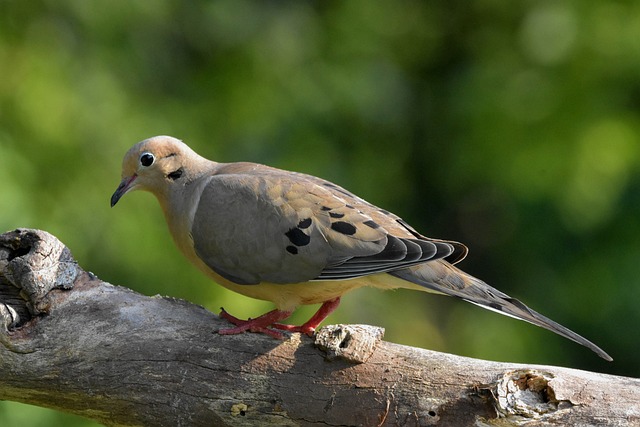
Mourning dove. Image courtesy Pixabay.com
White-winged doves are slightly larger than mourning doves, but they otherwise look very similar. Watch for a white bar on the upper wing surface and a rounded, rather than pointed, tail.
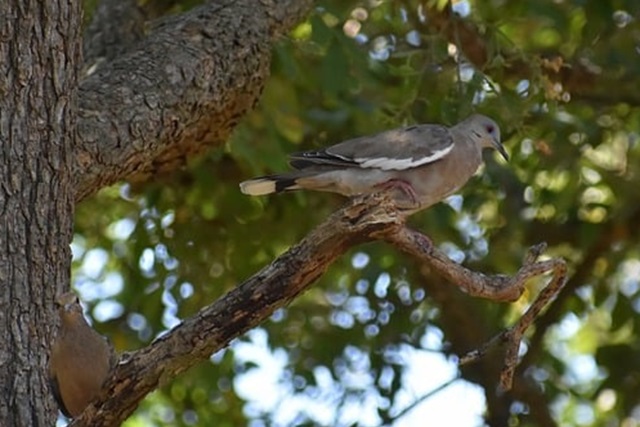
White-wing dove. Image courtesy Pixabay.com
You can hunt both species provided the combined total doesn’t go over possession and bag limits.
Another option is hunting the invasive Eurasian collared dove. They’re bigger than the mourning dove, have a pale gray body, and a black collar on the nape of neck. Also look for a black bill and a squared tail.
Eurasians are found almost everywhere, and in some states you can hunt them year-round with no limits.
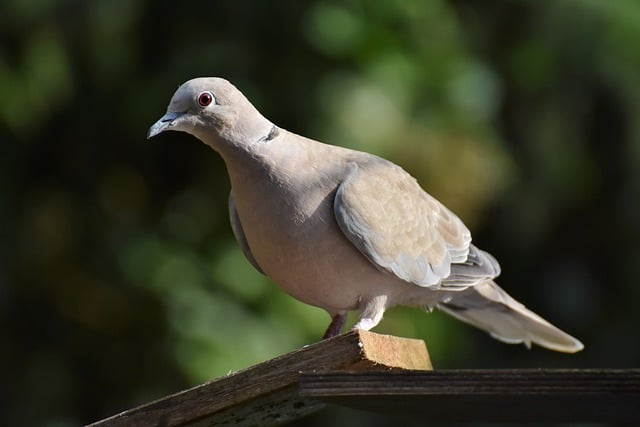
Eurasian dove. Image courtesy Pixabay.com
Next in consideration is the where. Doves need three things – food, water, and gravel. A place to roost nearby is also a consideration.
They love wheat stubble and fields with harvested sunflowers, but any place with seeds can attract them. They’ll even stop at ponds with exposed banks and weed cover. Unfortunately many of those places are not available to hunters. Some might be private property and others could be too close to houses.
You can ask farmers if you can hunt on their property. Also check for state-managed fields that are publicly-accessible. Another option is a hunting club. Members can schedule a hunt on the club’s property which can be thousands of acres.
Lastly is the when. Mourning dove season starts on September 1 in most states, but check with your state to be sure. Eurasian doves can be hunted year round in some states. There are also other dove species which varies by state. Check state websites or ask for a rule book at your local hunting store.
Dove hunting equipment and gear
Hunting license
Mourning doves are protected under the Migratory Bird Treaty Act so you’ll need a valid hunting license with a Migratory Game Bird Endorsement. Every hunter must also enroll in the HIP (Harvest Information Program) and carry proof of enrollment.
Shotgun
Federal regulations require repeating shotguns (pump and semi-auto) be plugged so they can only hold three shells. That includes one in the chamber.
For dove hunting, use an improved cylinder or modified choke for a wider, more open, pattern. A tight pattern makes it harder to hit fast-flying birds, and if you do connect it could tear up the bird.
If you use a double barrel, shoot with an improved cylinder first. Then for a second shot use a modified choke to hit the bird at a longer distance.
Shells
Smaller shot sizes, such as 7, 7-1/2, or 8, are best for dove hunting. These smaller sizes will put more pellets down range which should help you harvest more birds.
Doves are fast and rather acrobatic, so bring more shells than you think you’ll need. A good estimate is five shells for each bird you’re allowed to harvest, so 75 shells for a limit of 15 birds. Better to have too many than not enough!
Also be sure to check state regulations regarding the type of shot allowed. Steel shot may be required on state land or if you’re shooting over water. On private land, ask the property owner if he has a preference.
Clothing
A great thing about dove hunting is you don’t need a lot of expensive equipment or special clothing. I usually wear a pair of jeans and an earth-tone or camouflage shirt. Doves seem more concerned about movement than clothing.
If it’s a long walk in to your hunting spot, make sure your boots are well-fitting and broken in.
Wear a bird vest, preferably in blaze orange for your safety in the field.
Eye protection
Rose or amber-tinted glasses will protect your eyes from UV rays and stray birdshot. They also improve your depth perception so you can separate targets from the background.
Hearing protection
This is a must-have. One unprotected gunshot can cause significant damage to your hearing. And once your hearing is damaged, it can’t be repaired.
There are a variety of options available from the disposable foam earplugs to custom fitted hearing protection. Learn more about the options for ear protection in this Complete Guide. Choose what works best for you.
Sunscreen
Although a lot of other hunting seasons are in the cooler months, dove season is often warm and sunny. Be sure to apply sunscreen on any unprotected skin.
Water
Bring enough for you and for your dog.
Beyond the must-haves, here are some nice-to-haves
A trained retriever
A well-trained dog can make your time in the field so much easier. When my friend, Tom, and I hunted along a creek bed the birds seemed to know where we were and took a detour. So I sent my Lab up on the bluff to the west of the creek.
She not only handled her main duty of fetching the birds we shot, but also worked as a “traffic cop.” Her presence on the bluff had the birds flying along the creek bed and very near to us.
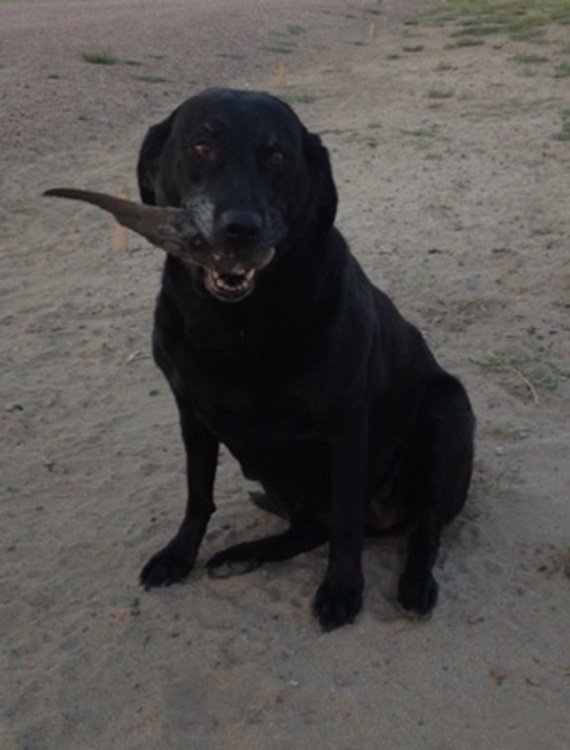
Having two dogs retrieving got the birds out of the field quickly. They also made it possible to find downed birds where the grass was thick and deep. However you must be aware of where each dog is at all times. In thick cover you might add a bell or beeper to their collars.
The best dove hunting dogs are trained well. Skills needed include:
- steadiness
- marking ability
- familiar with gunfire and whistle commands
- experience retrieving upland birds (very different from waterfowl).
If your dog hasn’t hunted doves before, set up a mock hunt that simulates what the dog may experience. If you normally fill your 15 bird bag limit, do a lot of shooting & retrieving. Or if you usually only see a few birds then include lots of sitting and waiting.
Safety tips for dove hunting with a dog
If your dog is young and/or inexperienced, know that your attention will be divided. If he’s not rock solid steady, keep him on a leash while anyone is shooting.
Because it’s often quite warm during dove season, make sure your dog doesn’t overheat. Provide water and as much shade as possible.
Also be aware of potential dangers in the field, such as snakes, barb-wire fences, holes, and snags. Several years ago there was a fast-moving dog that hit a hole, somersaulted, and broke his back.
Your dog’s safety is more important than shooting another bird.
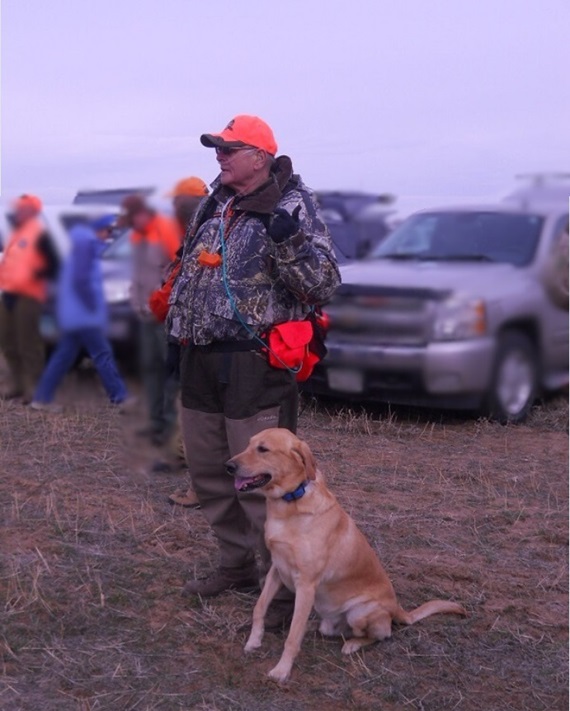
My good friend, Tom, and his yellow Lab, Woody.
A bumper for your dog
Sometimes the birds just don’t cooperate. When that happens, toss the bumper for your dog to retrieve.
Forceps
Walking in to our spot on the creek required crossing a large patch of yucca and prickly pear cactus. The dogs were excited to go, but not so happy about the stickers. Before our next hunt we bought some forceps to pull the spines without pricking our fingers.
Other suggestions I’ve heard are to brush white glue or rubber cement over the stickers, let it dry and peel off. Using duct tape may also help.
Decoys
Doves respond well to decoys and they’re not that expensive. Cabela’s offers some sets of 4-6 decoys for $20-30. Motorized decoys will cost $50 or more, but it’s worth the expense as doves decoy to them from a distance.
For a really inexpensive DIY set of decoys check out the article from Colorado Outdoors Magazine. Then use some clips to attach them to fencing and branches.
Blind to hide behind
Where I hunt there are lots of trees to hide behind so I don’t bring a blind. I do have a small one I made out of gunny sacks and a couple of hot wire poles in case I ever need it. But if you’d rather not DIY there are plenty for sale online.
Something to sit on
Depending on how far you have to hike in, you may want something to sit on or decide it’s not worth the trouble.
I like a bucket with a cushioned swivel top. It makes it easy to carry what I need including ammo, water, sunscreen, and plastic bags.
Knife or game shears, resealable bags, and an ice-filled cooler
Everyone has their own way to field dress doves, but it’s important to get them cooled down as soon as you can. I put them in a bag and pop them in the cooler until there’s time to dress them out.
Once the action slows down, I’ll pluck the breast feathers and peel off the skin. Then cut the breast from one of the wings, leaving a fully feathered wing attached. It’s quick, easy, and few feathers are left to fly around.
Other people will pluck the entire bird after removing the head, feet, wing tips, and entrails. The trick, they say, is to pluck the birds while they’re still warm. Just remember you may need to prove the bird’s species. The easiest way is to leave a fully feathered wing attached.
Preparing for your hunt
Even if you have a favorite spot, check everywhere you might hunt in the coming season. Something about the location might have changed causing doves to avoid it. Land ownership could have changed as well.
Drive around areas that doves might like. Look for birds sitting on power lines near croplands or flying in or out of a field. Watch for doves on gravel roads where they can consume grit to help digest their food.
Although their natural foods are sunflowers, foxtail, and grasses with small seeds, they are also attracted to croplands.
Also look for a water source nearby. In warm weather doves will fly to water several times in a day. The water can be as small as a puddle, but look for water that doesn’t have a lot of vegetation around it. Doves are more vulnerable on the ground and prefer a good field of vision.
When you find a likely area, ask the landowner for permission if it’s private property. Or if it’s state land, check the regulations.
You might also try contacting the local conservation officer. He may know of food plots planted for upland game on state lands. Or he could suggest landowners for you to contact. If the landowner gives you permission, you should thank him with at least a note or a few birds you shot on his property.
Hunting methods
Pass-shooting
Doves like to feed in the early morning and in the afternoon. If you’re in the right place at the right time, you’ll see them moving from feeding ground to water and then to roost. During the middle part of the day, they’ll mostly hang out on power lines or in trees.
Things to keep in mind:
- Doves like to be part of a flock. If you see a few birds, wait a bit to see if others come along. Watch where they go. Look for a place along that flight line where you can set up.
- Best times to see doves are just before sunrise and about an hour before sunset. In the morning, they’re heading out to feed. In the evening, they’re going to get a drink.
- Pay attention to the prevailing wind.
- Look for a place where you can blend in, rather than being silhouetted against the skyline. And then stay still while birds are flying.
- As seed eaters, doves will walk around on the ground looking for seeds. And they prefer open ground so they can see approaching danger.
- They also want to be fairly close to water. Generally they’ll eat in the morning and afternoon, then get a drink, and finally head for a roost.
- Another place to check are areas with sand or gravel. Doves will visit these areas after feeding because they need grit to grind down the seeds.
- Doves are fast fliers so you need to aim where they’ll be and not where they are. Focus on the bird’s head and add a four to six foot lead. Increase or decrease the lead until you find your sweet spot. Be sure to continue swinging through the bird as you shoot.
Decoying doves
Doves will decoy. One or two spinners can be seen from a distance and will bring doves in close. Wing flapping decoys look more natural, but can’t be seen as far.
Adding some static decoys set out to look like they’re feeding, drinking, or roosting will help incoming birds think it’s safe. Just make sure the decoys are easy to see.
Even silhouettes clipped onto tree branches and fences can work.
However when shooting over decoys, be aware that your shots may be lower. What can be hit with a low shot? A building? Other hunters? A dog?
Regulations
Be sure to read a copy of your state’s regulations.
You can’t hunt over an area where “bait is present that could lure or attract birds ‘to, on, or over areas where hunters are attempting to take them.'” So watch for grain or other feed in the area where you plan to hunt. If it’s due to agricultural planting and harvesting, you should be fine. However if the grain is in piles, you should find another place to hunt.
Some tips from Arizona Game & Fish:
- Don’t shoot within 1/4 mile (440 yards) of an occupied structure while hunting unless you have permission
- Don’t shoot from, across or into roads or railways
- Don’t leave shotgun shells or other litter on the ground
- Don’t hunt over water all day — allow time for livestock to access water
- Don’t consume drugs and/or alcohol while hunting or handling firearms
Terms you should know
“Motorized vehicles. You cannot hunt migratory game birds from or by means, aid, or use of any motor vehicle, motor-driven land conveyance, or aircraft (if you are a paraplegic or are missing one or both legs, you may hunt from a stationary car or other stationary motor-driven land vehicle or conveyance).
“Shooting hours. You cannot hunt migratory game birds except during the hours open to shooting.
“Closed season. You cannot hunt migratory game birds during the closed season.
“Daily bag limit. You can take only one daily bag limit in any one day. This limit determines the number of doves you can have in your possession while in the field or while in route back to your car, hunting camp, home, or other destination.
“Wanton waste. You must make a reasonable effort to retrieve all doves that you kill or cripple and keep these birds in your actual custody while in the field. You must immediately kill any wounded birds that you retrieve and count those birds toward your daily bag limit. Your birds must remain in your possession while in the field. You cannot give your birds to another person in the field regardless of whether or not they are properly tagged.
“Tagging. You cannot put or leave migratory game birds at any place or in the custody of another person unless you tag the birds with your signature, address, number of birds identified by species, and the date you killed them.
“Dual violation. A violation of a State migratory game bird regulation is also a violation of Federal regulations.
“Migratory Bird Harvest Information Program (HIP). Each hunter is required to enroll in the HIP and carry proof of such enrollment.
“Protected birds. Federal law prohibits the killing of non-game migratory birds. Protected birds that you may encounter while dove hunting include songbirds, eagles, hawks, owls, vultures, killdeer, nighthawks, herons, egrets, and woodpeckers.”
After the hunt
Care for your dog
Run your hands over your dog’s face, ears, body, legs (including “arm pits” and groin) and between his toes. You’re looking for injuries, bumps that could be ticks, foxtails, and cactus or other stickers.
Be sure to offer water as well.
Finish prepping birds
If you’ve already started preparing your birds, just cut off the remaining wing and clean the breast. Otherwise finish preparing your birds whether you’ll cook the entire bird or just the breast.
I like the time-tested recipe – wrapped in bacon with a slice of jalapeño. Although I admit I like a milder pepper and often use a poblano instead.
Doves are tiny but tasty. The breasts are dark red meat that tastes like beef, or like little duck breasts, if you cook it rare. Breasting a dove is simple and takes seconds, leaving you with about an ounce of meat per dove. You can leave the meat on the keel and make the ever-popular dove popper, a cream-cheese and jalapeno-stuffed breast wrapped in bacon, or you can filet those two bites off the breast and use them in a kabob or stir-fry. And, again, the meat will be delicious rare, and unpleasantly liver-like if you cook it too much.
If you’d like something a little different, check out Hank Shaw’s dove recipes.
Final thoughts
Dove are quick, fun, and tasty. I look forward to September not only as the start of hunting season, but also for soon-to-be cooler weather.
Enjoy your time in the field, whether it’s with hunting buddies or just your favorite dog.
Header photo by Aaron J Hill/Pexels
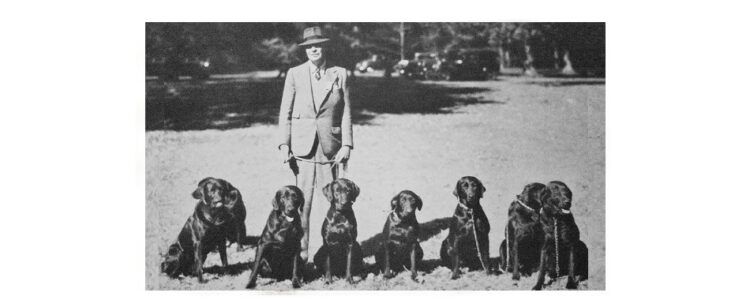
Jay Carlisle (and his Wingan Kennel) was “…undoubtedly the one to whom most credit is due for the rise in the popularity of Labradors in the U.S.A.”
– Labrador Retriever Club Yearbook, 1931-1944
Imagine, if you will, the sprawling mansions, huge parties, and nouveau riche of The Great Gatsby era. The Great War had ended, Prohibition brought speakeasies and organized crime, and the stock market crashed. It is in such a setting we find Jay Carlisle and his Wingan Kennel.
Born in Brooklyn in 1868, Carlisle was a stockbroker and the Governor of the American Stock Exchange during the 1929 crash. His wife was Mary “May” Pinkerton Carlisle. (Yes, that Pinkerton family.)
Carlisle was also a sportsman. His horses ran on the track or competed in shows. He rode to hounds and played polo. And he fished and hunted.
We pick up his story when Carlisle turned his attention to Labrador Retrievers.

Image courtesy East Islip Historical Society – www.eastislip.org
Step 1 – Import the Best Labradors
Jay Carlisle liked a good-looking dog, but he wanted more. He wanted dogs with an acceptable show record and qualified in the field. “Once Mr. Carlisle had decided that the Labrador was to be his breed, he began a study of existing blood lines. He went over countless records, and all the time he had in mind the qualities that he wanted.” 1
After breeding, raising, showing, and racing horses, he developed a discerning eye. However, in the early 1930s, the Lab was still new to America and field trials were just getting started. Carlisle promised to make the breed as popular in America as it was in Britain.
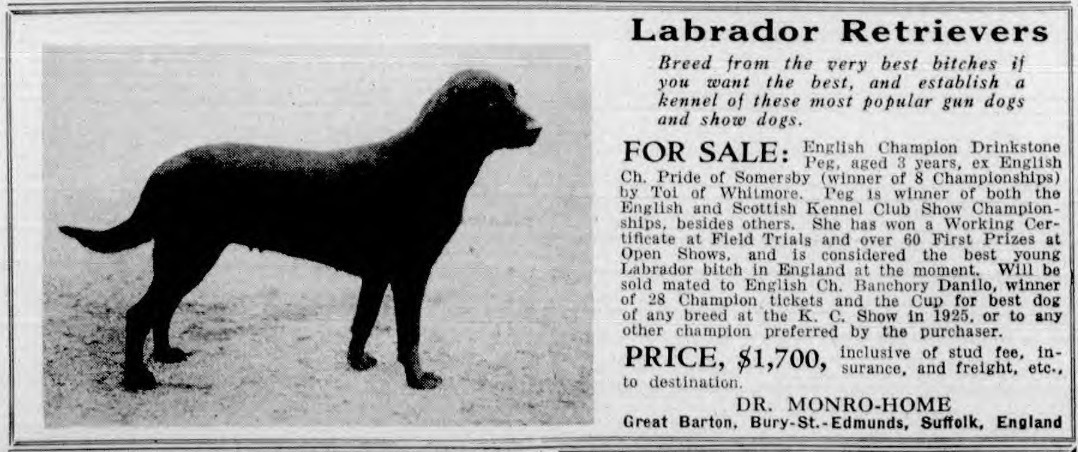
Peg was offered for sale for $1700. Today’s equivalent is about $30,000.
After researching, he imported nine of the finest Labs to start his kennel. The best of these was English Champion Drinkstone Peg of Wingan. She was born in 1927 and bred by Dr GH Monro-Home of Scotland.
Of the other eight Labs, three came from Lorna, Countess Howe.
Eng Am CH Drinkstone Peg of Wingan
Peg was sensational in the show ring and earned nine Challenge Certificates which are similar to ‘winning the points’ in America. Three certificates were enough for a championship, but she kept on winning.
In England there is a ‘show championship’ and a ‘full championship’. A full championship requires the dog to prove it can work in the field as well as win in the show ring. Peg earned her working certificate at the International Gun Dog League retriever trails in 1930 and became a full champion.
She also won her show championship in America. But despite being a top show dog, Carlisle was more interested in Peg’s potential for breeding. Of course the male is also important so he had her bred to Dual Champion Bramshaw Bob. He was one of England’s greatest show dogs and stud dogs.
Two months later Peg whelped seven puppies at Carlisle’s Wingan kennels.
After raising her puppies, she went back into the show ring and continued winning. One of her big wins was Reserve at the Westminster Kennel Club show in 1934.
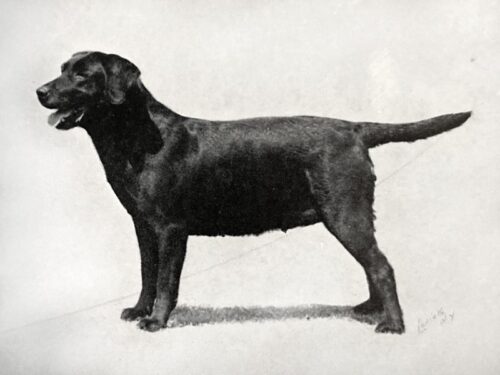
| Eng Am CH Drinkstone Peg of Wingan black female, born 4/18/1927 |
Toi of Whitmore FTW | Tyg of Whitmore |
| Bute of Trentham | ||
| Eng CH Pride of Somersby | Brayton Siddy | |
| Juno of Somersby FTW |
CH Drinkstone Pons
Another dog Carlisle imported was Drinkstone Pons. He was Peg’s son sired by English Champion Banchory Danilo and bred by Dr Monro-Home.
Pons started his show career as a puppy. He won many prizes and was often chosen as the best Labrador, best retriever and/or best gun dog. Pons won Best of Breed at the Westminster Kennel Club show – twice – and also won second in the group competition. He won Best in Specialty Show at the annual Labrador Retriever Club Inc. show.
In 1934 he started running and placing in field trials. He won the Open novice stake the the Brookhaven Game Protective Association trial with kennel mates Night Light and Ben taking second and third. A New York Times reporter said “The placed dogs showed the influence of the highest breeding, combined with thorough training. All the Wingan representatives exhibited intelligence in their hunting, with a minimum of direction from their handler.” 2

| CH Drinkstone Pons of Wingan black male, born 5/11/1931 |
Eng Ch Banchory Danilo FTW | Eng Dual Ch Banchory Bolo |
| Munden Scarcity | ||
| Eng Am Ch Drinkstone Peg of Wingan | Toi of Whitmore FTW | |
| Eng Ch Pride of Somersby |
Drinkstone Mars
Mars was another outstanding dog. He often won in the show ring and earned his certificate of merit under judges Countess Howe and the Honourable Mrs. Hill Wood.
Pons and Mars were littermates and won the brace class together. Mars won the points toward his show championship at the Labrador Retriever Club Inc. specialty show in 1934. And as a dual purpose Labrador, he also won in field trials.

| Drinkstone Mars of Wingan black male, born 5/11/1931 |
Eng Ch Banchory Danilo FTW | Eng Dual Ch Banchory Bolo |
| Munden Scarcity | ||
| Eng Am Ch Drinkstone Peg of Wingan | Toi of Whitmore FTW | |
| Eng Ch Pride of Somersby |
CH Liddly Bulfinch of Wingan
Bulfinch was another import and was bred by H.A. Richardson. He won about 50 times at championship shows and certificates of merit at field trials.
And he won the points at the Labrador Retriever Club Inc. annual specialty show in 1935. This means he defeated the other non-champion males and earned points toward his show championship.
Bulfinch completed his championship with a 4-point win at the Long Island Kennel Club show in May 1936.
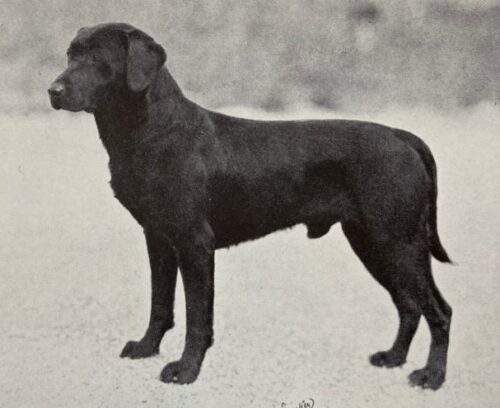
| CH Liddly Bulfinch of Wingan black male, born 2/7/1932 |
Eng CH Tar of Hamyax | Toi of Whitmore FTW |
| Sunshine of Fasham | ||
| Delyn of Liphook | Eng CH Banchory Danilo FTW | |
| Ridgeland Black Diamond |
FC Banchory Night Light & CH Banchory Jetsam
Banchory Night Light and Banchory Jetsam were littermates sired by Blackworth Midnight. They were bred by Miss L. Croad of England.
In 1935 Field and Stream Magazine began offering a challenge trophy to the dog that earned the greatest number of points. Only competition in Open All Age Stakes counted.
Night Light was one of the top Labradors and earned 12 points in the contest. Banchory Varnish of Wingan earned 10 points and Glenairlie Rover was tied with Blind of Arden at eight points.
He was a Field Champion and major pointed in dog shows. Jetsam was a Show Champion which included winning the points at the Westminster Kennel Club show in 1934.
Tops of Bigstone, Night Light’s daughter, produced several quality dogs. These included Dual CH AFC Matchmaker for Deer Creek, FC AFC Ladies Day at Deer Creek, and Kingdale’s Ink Spot.
It’s interesting that Night Light carried the chocolate gene while his sister, Jetsam, carried the yellow gene.
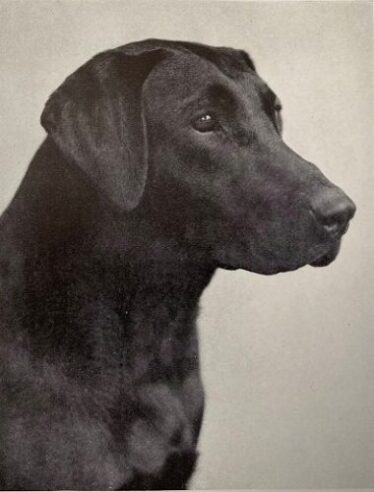
FC Banchory Night Light of Wingan

CH Banchory Jetsam
| FC Banchory Night Light of Wingan black male, born 1/1/1932 CH Banchory Jetsam black female, born 1/1/1932 |
Blackworth Midnight | Eng CH Wilworth Rip |
| Brookstone Jet CCW | ||
| Dinah of Wongalee | Eng CH Beningbrough Tangle FTW | |
| Wendy of Wongalee |
Banchory Dapper
Banchory Dapper was a half brother of Night Light and Jetsam, all sired by Blackworth Midnight. He won a 5-point major at the Labrador Retriever Club Inc. specialty show in 1934.
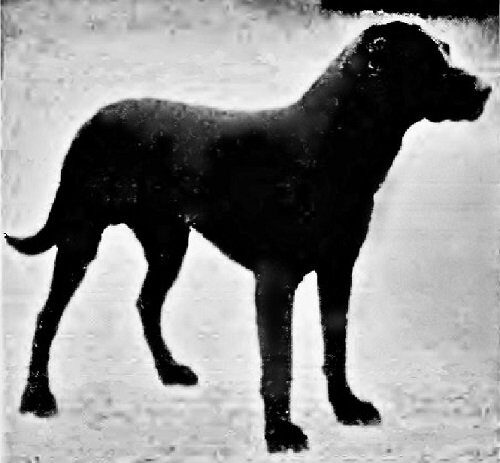
| Banchory Dapper black male, born March 1932 |
Blackworth Midnight | Eng CH Wilworth Rip |
| Brookstone Jet CCW | ||
| Banchory Student | Eng CH Banchory Danilo | |
| Eng CH Pride of Somersby |
Orchardton Doris of Wingan
Orchardton Doris was bred by S.H. Carruthers and worked as a field dog in Scotland.
After coming to America she was described as “a high class bitch with beautiful style, great pace and very keen… She and her handler, Dave Elliot, gave a beautiful exhibition of giving and taking direction to an unmarked fall by hand and whistle, without undue disturbance of ground on either side. She has an invariably excellent pick-up, carry and delivery.” 3
A fast and expert retriever, Doris also had several wins in the show ring.
She was the mother of Pons Junior of Wingan and Wingan’s Daily Double and the grandmother of FC Timber Town Clansman.

| Orchardton Doris of Wingan FTW black female, born 12/31/1930 |
Eng Ch Ingleston Ben | Duke of Kirkmahoe FTW |
| Ingleston Nancy FTW | ||
| Orchardton Dawn | Eng CH Brocklehirst Donner | |
| Hardies Choice |
Eng Sh CH Am CH Banchory Trump of Wingan
The ninth dog, Banchory Trump, stayed in England until he finished his show championship. After coming here, he finished his American show championship with Best of Breed wins at the Westminster Kennel Club dog show and at the Labrador Retriever Club Inc. specialty.
He won numerous Bests of Breed awards and placed in the group several times.
His Best of Breed winning streak included several very competitive shows:
- Morris & Essex, 5/23/1936
- The Labrador Retriever Club Inc, 6/27/1936 – Best In Specialty Show
- Morris & Essex, 5/29/1937
- The Labrador Retriever Club Inc, 6/18/1937 – Best In Specialty Show
- Westminster Kennel Club, 2/10-12/1938
- International Kennel Club, 4/2-3/1938
- Leavenworth Kennel Club, 4/27-28/1938 – Best Of Breed and Group 3rd
- Des Moines Kennel Club, 11/12-13/1938 – Best Of Breed and Group 4th
Trump sired females that passed on excellent genetics. Bred to CH Bancstone Lorna of Wingan he produced Huron’s Lady, the mother of Dual CH Grangemead Precocious. When he was bred to a daughter of Eng FTCh Banchory Varnish of Wingan he produced Peggy of Pheasant Lawn. Peggy was the mother of FC Pickpocket for Deer Creek and Bancstone Dinah, grandmother of NFC AFC Massie’s Sassy Boots.
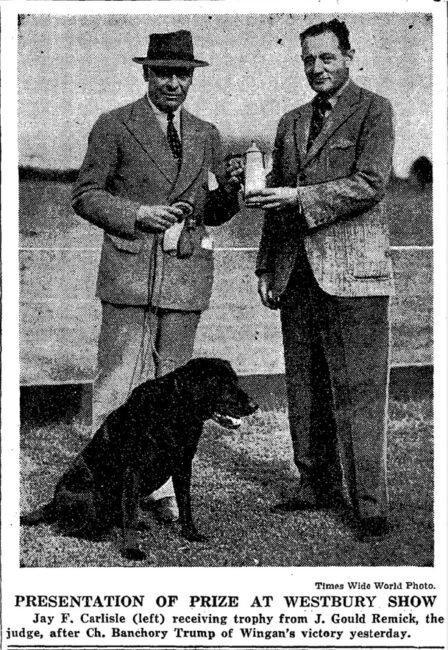
| Eng Sh CH Am CH Banchory Trump of Wingan black male, born 8/21/1931 |
Blenheim Scamp FTW | Balwearie |
| Blenheim Lady | ||
| Lady Daphne | Saffrons Bob CCW | |
| Haste |
Drinkstone Peg’s British litter
Below are Peg’s puppies by Eng Dual Ch Bramshaw Bob.
| Litter bred in England and born in America Born 8/7/1933 |
Eng Dual Ch Bramshaw Bob | Eng Ch Ingleston Ben |
| Eng FTW Bramshaw Brimble | ||
| Eng Am Ch Drinkstone Peg | Eng FTW Toi of Whitmore | |
| Eng Ch Pride of Somersby |
CH Bancstone Ben of Wingan
Owned by J.F. Carlisle
Ben placed in field trials and also did very well in shows. He finished his show championship with multiple five-point majors.
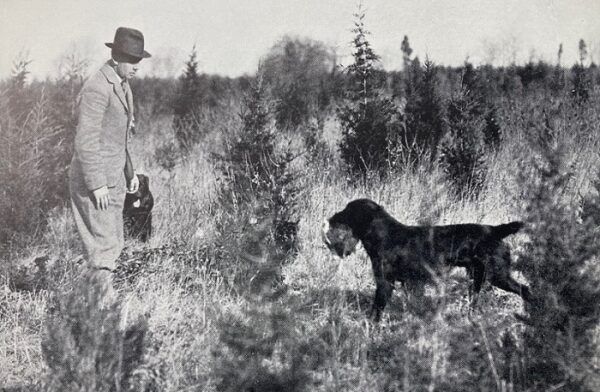
Bancstone Blair of Wingan
Owned by J.F. Carlisle
Although he wasn’t shown much he almost always won his class and even won Best of Breed.
CH Bancstone Bob of Wingan
Owned by J.W. Redmond
Bob also finished his show championship with three five-point majors – including at the Westminster Kennel Club dog show in 1937.
Bancstone Doctor of Wingan
Owned by J.F. Carlisle
Although Doctor was also shown, he didn’t finish his championship.
CH Bancstone Countess of Wingan
Owned by J.F. Carlisle
Countess won Reserve Winners Bitch at both the Westminster Kennel Club dog show and the Labrador Retriever Club specialty show. She finished her championship title with two 5-point and two 4-point major wins.
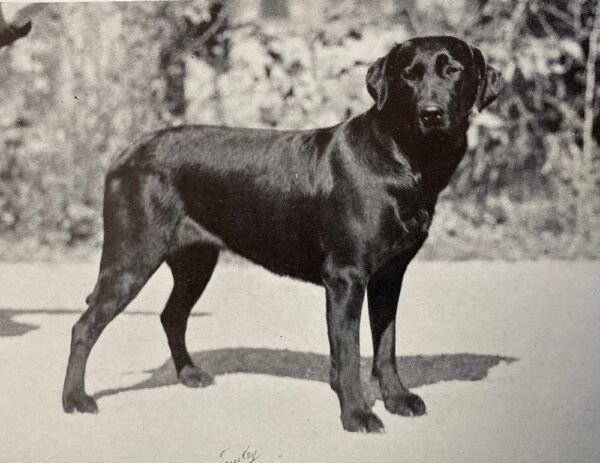
CH Bancstone Lorna of Wingan
Owned by J.F. Carlisle, later by James R McManus
Another Wingan-bred show dog that finished her championship with three 5-point majors. And she won Best in Specialty Show at the Labrador Retriever Club specialty show in 1935.
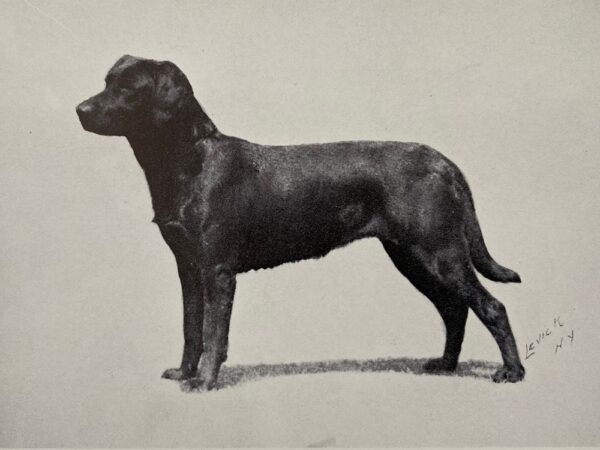
Bancstone Peggy of Wingan
Owned by J.F. Carlisle, later by C.H. Mackay
Although she was halfway to her show championship, it appears she never finished her title.
Other Labs
Carlisle had many dogs – some he bought and some he bred. Here are a few of his better known Labs.
Eng FTCh FC Banchory Varnish of Wingan
Owned by J.F. Carlisle, later by Mrs. Kathleen B. Starr (Timber Town)
In April 1937 Varnish won the Open all-age stake at the Long Island Retriever Field Trial Club. He was described as “consistent in his work throughout a long day … in which champions and top field-trial dogs fell by the wayside.” He “did all that was asked of him in his work on land, quartering, taking direction, showing intelligence in his questing and exhibiting nose for his game.” 4
He also won the Open stake at the Brookhaven Game Protective Association trial in the fall of 1937. “In the second series, his first bird was easy; but the second was dropped across the road in back of motor cars and gallery. The dog worked out the problem, however, and retrieved the bird in grand shape. In the third series, his speed and precision could not possibly escape the notice of the judges while his marking was exceptional.” 5
The gallery cheered their old-time favorite.
Varnish was also pointed in the show ring.
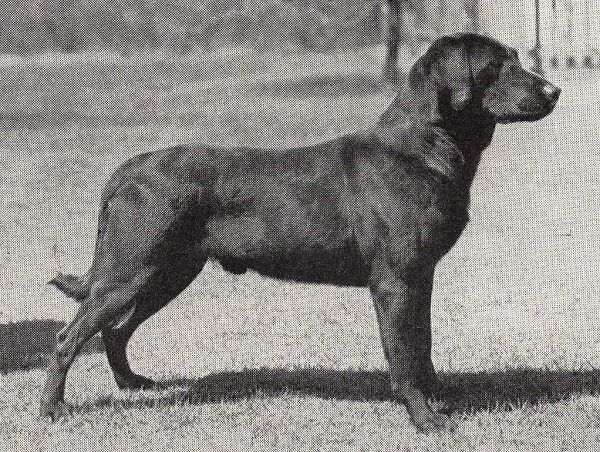
| Eng FTCh FC Banchory Varnish of Wingan black male, born May 1933 |
Eng Dual Ch Banchory Painter | Eng Ch. Peter the Painter |
| Glenhead Bess | ||
| Hawkesworth Glimmer | Banchory Tealer | |
| Bramshaw Gloss |
Pons Junior of Wingan
Pons Junior won the Brookhaven amateur trial handled by Mrs. Kathleen B. Starr (Timber Town kennels). He was described as making “two grand retrieves in the water test, going out on a surveyor’s line to both ducks.” The stake was judged by Colonel the Lord Vivian, D.S.O., of Britain, and David Wagstaff of Tuxedo Park, NY. 6
He also did well in the show ring including winning Reserve Winners Dog at the Westminster Kennel Club dog show in 1937.
A year later Timber Town Clansman, his two-year-old son, won the Women’s Field Trial Club non-winners stake.
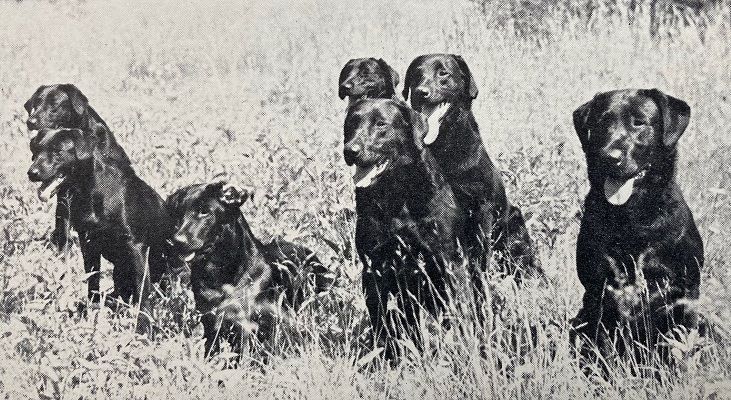
Rear, left to right: Pons Junior, Ebony of Barrington, Banchory Night Light, CH Drinkstone Pons. Front: Whitecairn Wendy, Banchory Varnish, CH Bancstone Ben.
| Pons Junior of Wingan black male, born 4/30/1934 |
Drinkstone Pons of Wingan | Eng FTCh Banchory Danilo |
| Drinkstone Peggy | ||
| Eng FTW Orchardton Doris of Wingan | Eng Ch Ingleston Ben | |
| Eng FTW Orchardton Dawn |
Okanagan Sandy
Sandy was bred in Canada and was special enough to earn a place at Wingan Kennels. One of the field trials he ran was under particularly difficult conditions.
“Six dogs were called back for the final elimination with the sea pounding on the outer bars, whitecaps making in the inlet and snow squalls driving inland. Dog after dog was sent into the icy water. Suddenly the black clouds closed down and the whole world was shut out by a driving snowstorm….
“Sandy’s water work was little short of perfection, he taking to the water with a huge splash, after having marked his two falls…” 7
| Okanagan Sandy black male, born 4/5/1934 Bred by R. Leckie Ewing, Canada |
Beaver of Bryn | Banchory Jock |
| Munden Stigma | ||
| Gay’s Vesta | Eng Nat’l FTCh Beningbrough Tanco | |
| Eng FTCh Vidi of Adderley |
Okanagan Tanco
Tanco was another import from Canada. In November 1936, he won the Derby stake at the Labrador Retriever Club trial in Peapack, NJ.
As the winner, he brought home the directors’ trophy and $25. Although that doesn’t sound like much it’s the equivalent of over $500 today.

| Okanagan Tanco black male, born 6/17/1935 |
Okanagan Rusty | Beaver of Bryn |
| Okanagan Gyp | ||
| Gay’s Vesta | Eng Nat’l FTCh Beningbrough Tanco | |
| Eng FTCh Vidi of Adderley |
Orchardton Duce of Wingan
Owned by Jay Carlisle, later by Mrs Eleanor F. Remick
Duce won the Labrador Retriever Club’s Derby stake at 14 months old. Colonel the Lord Vivian, D.S.O., of Cornwall, England judged together with Dr. Samuel Milbank and Francis Squires. The trial was held at Shinnecock Hills in Nov 1937.

| Orchardton Duce of Wingan black male, born approximately Sep 1936 |
Eng Ch Orchardton Donald | Eng Ch Ingleston Ben |
| Orchardton Dawn | ||
| Mona Of Ammurrness | Eng FTCh Tag of Clava | |
| Queen of the May |
Whitecarin Wendy of Wingan
Owned by Jay Carlisle
Wendy won the Open stake at the Brookhaven Game Protective Association field trail in 1935. The weather was described as “almost ideal, the thermometer hovering around the freezing mark, and the wind was just strong enough to make it a sporting proposition for guns and dogs.” 8

| Whitecarin Wendy of Wingan black female, born approximately 1933 |
Ranger of Kentford | Gift of Halleaths |
| Kirkbean Gyp | ||
| Lochar Kate FTW | Eng Dual Ch Banchory Bolo | |
| Murrayfield Bet |
Wingan’s Daily Double
Another Wingan dog deserving of mention is Daily Double. Bred by Carlisle and sold to Howes Burton, an amateur, who handled her himself. She won at the Long Island Retriever Field Trial Club in 1939 and placed second in what was called “fast company” just a week before. The winner in that trial was Earlsmoor Moor of Arden.
However what makes her special is the combination of pedigree and offspring. She was a half-sister to Blind and Decoy of Arden on her father’s side. And a half-sister to Pons Junior on her mother’s side.
When bred to Eng FTCh Glenairlie Rover, she produced Mint of Barrington who in turn sired NFC AFC Marvadel Black Gum “Blackie”.
Blackie was High Point Derby dog in 1946. He won his first Open stake at 16 months of age and finished his field championship the next year. And he qualified for eight consecutive National Opens (1946-1953), winning in 1949.
| Wingan’s Daily Double black female, born 7/9/1936 |
Odds On FTW | The Favorite FTW |
| Jest | ||
| Orchardton Doris of Wingan FTW | Eng CH Ingleston Ben | |
| Orchardton Dawn FTW |
Step 2 – Build the Best Kennels
Instead of a heated kennel building with attached runs, Jay Carlisle built condos for his Labs. He felt it would be hard for the dogs to go from a heated kennel to retrieving in icy water.
Each condo was 6×11 feet, made out of redwood and set on 4x4s to avoid rot. Inside were two rooms – a 5×6 foot vestibule that became a shaded porch in summer and a 6×6 foot sleeping compartment with a hallway to avoid drafts.
They even had lights, windows and a hinged roof for cleaning.
The condos were set in 20×30 foot concrete runs with trees for shade. Puppies had a similar set up in a larger grass run.

Nearby was the feed house where they stored supplies and prepared meals for the dogs. Puppies were fed five meals a day – cereal with milk in the morning, cooked beef, raw beef, milk and biscuit and a big-dog meal.
Adult dogs got cooked meat twice a week with commercial food, cod liver oil and yeast. Occasionally they got salmon or raw beef.
Step 3 – Import the Best Help
While Jay Carlisle was looking for the best Labs, he was also looking for someone to train the dogs. For that he looked to Scotland where many men learned the business as kennel men and game raisers.
With the help of Countess Howe and many others, Carlisle found the right man. In 1934 he brought David D. Elliot to Long Island from Scotland.

A few months later at the Brookhaven Game Protective Association trial they swept all three places in the open novice stake. Drinkstone Pons of Wingan won $50 for first place. That’s over $1000 in today’s currency. Second place and $30 to Banchory Night Light of Wingan. Third place and $20 to Bancstone Ben of Wingan.
Carlisle did indeed find the right man to run his kennel.
David D. Elliot
Elliot grew up near Edinburgh, Scotland, where he learned about sheepdog trials from his grandfather. Watching how the sheepdogs responded to signals gave him the idea to teach signals to Labs. A form of these signals is still used today to guide dogs on blind retrieves.
Lady Howe, Dr. Monro-Holm and David Black (breeder of Peter of Faskally) recommended Elliot as a kennelman for Carlisle. Elliot agreed to come for five years, but instead, he stayed for a lifetime.
In addition to training dogs, he also trained people. They included Dorothy Howe (Rupert), Joan Redmond (later Joan Reed, Chidley) and Kathleen Starr (later Mrs Fredricks, Timber Town). The ladies were sometimes called “Elliot’s Harem.” Cotton Pershall was another person who learned how to handle dogs at Wingan.
Carlisle was pleased with Elliot’s training and thanked him for introducing him to field trialing. The competition made him happy despite the recent death of his wife.
If you’d like to see Elliot and two of his retrievers – Eng FTCh FC Banchory Varnish of Wingan and FC Timber Town Clansman – check out the “Sky Game” video, filmed in 1939.
Step 4 – Promote the Kennel and Competition
Jay Carlisle registered Wingan as his kennel name in 1933.
He ran ads in a variety of magazines – from the AKC Gazette to Vanity Fair.

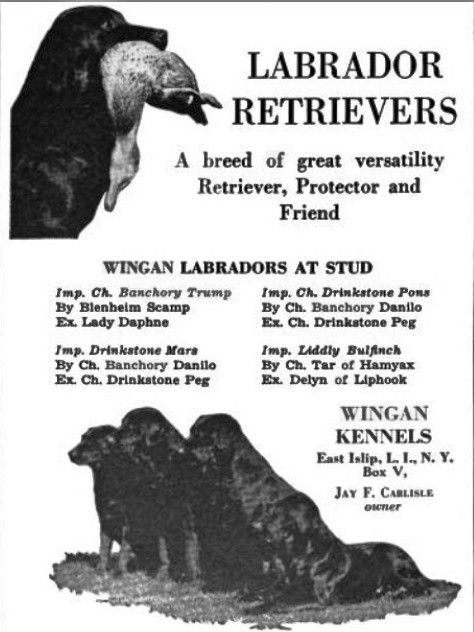

He served as President of the Labrador Retriever Club from 1935-1938. During that time he established the Amateur stake and donated a perpetual trophy so the stake would continue.
Carlisle, Anthony Bliss, Franklin Lord, Gould Remick, Henry Root Stern, and Leonard Buck formed the Long Island Retriever Trial Association. The club’s purpose was to encourage the breeding, training, and use of retrievers, and for holding of all-breed retriever trials.
David Elliot wrote a book about Labs and training them and Carlisle published it in 1936. It included training advice and many photos of Wingan Labradors.
“The efforts and absorbing interest of J. F. Carlisle, his participation in trials and at shows, and his generous offering of dogs at stud to new breeders gave the breed a tremendous push forward in this period. He helped to form a nucleus of good material to build upon, together with the superb group of imports… All this gave the breed the right start, and it was not long before history repeated itself, so that the Labrador was on its way to overtaking all the other Retriever varieties in the New World, as it had in the Old.” 9
The End and a Beginning
Jay Carlisle died in 1937, just eight months after his wife.
He was so respected, that 28 prominent men volunteered to act as pallbearers. A special train transported guests from Penn Station in New York City to Carlisle’s home in East Islip, Long Island.
The retriever community postponed a field trial so contestants could attend his funeral. However the postponement meant the trial had to be limited in order to finish in one day. This was the start of Limited All-Age stakes.
The Labrador Retriever Club, Inc. set up a Jay Carlisle Memorial Trial. It was held from 1938 to 1941 near his home on Long Island. Mrs. Hill-Wood, Morgan Belmont and Robert Morgan judged the first Memorial Trail.
On a sad note, the contents of his home went to auction in 1938 and his beautiful mansion was demolished in 1940.
Most of his dogs were given to the young Scotsman, David D. Elliot. He also received the specially-modified green and yellow dog wagon and the right to rent the Wingan kennel at a reduced rate.
Although it seems like a sad ending, the dogs did continue competing with Elliot. And many people recognized Carlisle’s contribution to Labradors and to field trials in America.

David Elliot (right) with Banchory Night Light winning the Field & Stream Challenge Cup for Outstanding Retriever of 1937.
Today
Few people recognize the Wingan name today or they confuse it with Helen Ginnel’s Whygin kennel. But Carlisle’s efforts – importing quality dogs, making his stud dogs available, and promoting Labradors – helped make the breed as popular in America as it was in England.
I’m proud to have several dogs that trace back to the Wingan Labradors.
— Chip and his descendants trace to –
* NFC Banchory Night Light of Wingan (grandsire of Dual CH Matchmaker for Deer Creek)
* Am Eng CH Banchory Trump of Wingan (grandsire of Dual CH Grangemead Precocious and FC Pickpocket for Deer Creek)
* CH Bancstone Lorna of Wingan (granddam of Dual CH Grangemead Precocious)
* Penney of Wingan (dam of NFC AFC Massie’s Sassy Boots)
— Dee and her descendants trace to –
* CH Banchory Jetsam
* NFC Banchory Night Light of Wingan (grandsire of Dual CH Matchmaker for Deer Creek)
* Am Eng CH Banchory Trump of Wingan (grandsire of Dual CH Grangemead Precocious and FC Pickpocket for Deer Creek)
* Eng FTCh FC Banchory Varnish of Wingan
* CH Bancstone Lorna of Wingan (granddam of Dual CH Grangemead Precocious)
* Bancstone Blair of Wingan (grandsire of NFC NAFC CFC Major VI, 1993 Hall of Fame)
* CH Bancstone Peggy of Wingan
* Eng Am CH Drinkstone Peg (dam of the Bancstone litter by Eng Dual CH Bramshaw Bob)
* Orchardton Doris of Wingan (dam of Pons Junior Of Wingan and Wingan’s Daily Double)
* Pons Junior of Wingan (sire of FC Timber Town Clansman and great grandsire of NFC Dual CH CFC Bracken’s Sweep)
* Wingan’s Daily Double (granddam of NFC AFC Marvadel Black Gum)
Notes:
[1] Arthur Frederick Jones, “True Labradors and Traditions Live at Wingan,” American Kennel Gazette, February 1934
[2] Henry R. Ilsley, “Carlisle’s Entries Take All Three Places in Open Novice Retriever Stake,” New York Times, December 29, 1934
[3] Helen Warwick, “The Complete Labrador Retriever” (New York: Howell Book House, 1965), 137
[4] Staff correspondent, “Carlisle’s Labrador Beats 22 Dogs in Long Island Retriever Clubs Trial,” New York Times, April 18, 1937
[5] Ned Corey, “Banchory Varnish of Wingan First in Brookhaven All-Age,” American Kennel Gazette, December 1, 1937, 94
[6] Staff correspondent, “Brookhaven Field Trials Are Marked by Splendid Work and Keen Competition,” New York Times, October 31, 1937
[7] Henry R. Ilsley, “Retriever Laurels Annexed by Carlisle’s Dog at Trials Held in Snowstorm,” New York Times, November 29, 1936
[8] A.F.J., “Whitecairn Wendy of Wingan Wins Brookhaven’s Open Stake,” American Kennel Gazette, January 1, 1936, 168
[9] Warwick, “The Complete Labrador Retriever,” 126
Glossary:
- AFC – Amateur Field Champion
- Best of Breed – At a dog show, the dog that has defeated all the other dogs of its breed.
- Best of Opposite Sex – If a male dog wins Best of Breed, the best female wins Best of Opposite Sex, and vice versa.
- BLF / BLM – Black Labrador female or black Labrador male
- Brace class – Two dogs shown together that look very much alike.
- CCW – British Challenge Certificate winner (show win, but not a title).
- CH – Dog show championship
- Dual Champion – A dog that has won a show championship AND a field championship.
- English show champion (“Eng Sh CH”) – A dog that earned a show championship, but lacks the working certificate to be a full champion.
- FC – Field Champion (British FTCh) – A dog that has won enough in field trials to qualify for the field champion title.
- FTW – Field trial winner (not a title)
- Full champion – England requires Labradors to pass a working test in addition to earning a show championship.
- Major points – In the US, Winners Dog and Winners Bitch can each receive points based on the number of dogs defeated. It can be 0-5 points, with 3 to 5 point wins called “majors.”
- NFC – National Field Champion
- QAA or *** – A dog that has proved himself in the Qualifying stake and could enter the limited Open or Amateur stakes.
- Reserve Winners – The second best dog of its sex that has not completed a show championship.
- Winners (also Winners Dog or Winners Bitch) – In the show ring, males (“dogs”) compete against other males in various classes. Then the winner of each class competes against the other winning males for Winners Dog. Depending on the number of males defeated, the Winners Dog will receive up to 5 points towards his show championship. It works the same for females.
Animals, birds, and even insects have thoughts. Maybe not exactly like people, but animal communicators have a gift that can tap into those thoughts.
Animal communicators are people with a psychic ability to connect with animals on a deeper level. They use their intuition and sensitivity to better understand what animals are thinking and feeling.
These thoughts may come through as words, images, or feelings. They can take that information and translate it into a form a client can understand. This helps us understand animals better and can even solve behavioral problems or improve their well-being.
By learning what an animal is trying to tell us, we can build stronger and better relationships with them.
“The animals are waiting, curious and hopeful, for us to awaken, listen, and learn.” ~ Penelope Smith
Providing insight into what animals have to say
Communicators can connect with animals on a deep level to understand their thoughts and feelings. They’re often consulted when an animal becomes ill, develops behavioral issues, or is facing the end of their life. Sometimes communicators help find lost pets or scan an animal for physical or emotional pain.
They often describe entering a meditative state of consciousness to establish a mental connection with the animal. This connection allows them to receive and interpret information from the animal and then pass the information to the animal’s caretaker.
Sometimes communicators consult over the phone which is very helpful for large animal owners or when the communicator is far away. Similar to energy work, such as Reiki, distance doesn’t matter.
Techniques used by animal communicators
The communication process is like a radio. The broadcast station sends out radio waves at a particular frequency. People need to tune to that frequency to hear the broadcast. In this case the “broadcast station” is the animal sending thoughts, images, or feelings. We need to tune to the animal’s particular “frequency.”
Researchers are studying telepathic communication. Quantum physics has proven that we are connected by waves of energy.
We already use telepathy, perhaps without realizing it. Does your dog hide when you’re planning to take him to the vet? Or perhaps waits by the door before you get his leash? You may be doing something and all of a sudden realize your dog has to go out. Maybe he ran to the door. Or he rung a bell like he’d been taught. Or maybe he told you and it just flashed in your mind.
It’s something kids do naturally and mothers do with their children. However once we learn to speak, we place more value on verbal communication rather than on intuition.
With practice we can become more aware of thoughts, images and feelings animals share with us. Paying attention to body language and non-verbal cues also helps gain insights into the animal’s thoughts and emotions. Cues might include the animal’s posture, tail position and facial expressions.
Dogs are particularly good at communicating with body language. Think of the wagging tail or bared teeth. Or when they come to you and just stare. Perhaps they’re trying to will you to hear their thoughts.
There is more to it than interpreting actions or body language. You have to be open to it and pay attention when it happens. If you doubt, you may block what information the animal is sending.
Animal communication session
I had an interesting experience a few years ago at a dog show. As I was walking out of the building, I noticed a booth for an animal communicator. I discounted it at first, but then thought “what the heck.”
At first her communications were pretty generic. She said my dog, Chip, wanted to know how long Labradors live. He told her he was glad that I took good care of him and he wanted his granddaughter to take his place someday.
Did I really believe she was talking to my dog? Not at first, but something she said turned me into a believer as I was driving home.
She told me Chip was my self-appointed protector and he wanted me to get a new truck. He wanted a truck I could see out of.
It didn’t make much sense at the time.
On the way home, Chip was in the front seat with me. He was sitting on the passenger seat when I wanted to change lanes to the right. I glanced over and told him, “Lay down, I can’t SEE.” When I realized how often I say that, I became a believer.
When I told a friend about the experience, she wasn’t surprised. She had several experiences with an animal communicator.
Once when the communicator was walking to a specific horse, she stopped at another stall for a moment. Then turned to my friend and said the mare didn’t like her new stall. She didn’t know the mare had recently been moved from a stall near the barn doors.
Telepathic connection with wild animals
The video follows Anna, a communicator, as she visited a variety of animals. First we see her joining a group of wild baboons. She walked easily amongst them. When she laid on the ground, two baboons gently picked through her hair.
Later the alpha male walked to her and asked, “Who are you?” Anna told him she was there peacefully and the male accepted her presence. This was the same male that had attacked other people who got too close to the young baboons.
She visited several other animals, but the most poignant was a black leopard. He’d been abused in a European zoo which made him suspicious and ready to hurt anyone who got near him. Although he had a large enclosure for exercise, he refused to leave the shelter.
When Anna sat near the shelter, he calmed. She learned he had been kept in a small cage which was why he didn’t want to leave the shelter. He asked Anna about two young cubs that had been caged next to him. His keepers confirmed there had been leopard cubs in that cage, but hadn’t mentioned it to Anna.
After the session with Anna, the leopard seemed more calm. He left the shelter to explore the rest of the enclosure. His keepers said he was a changed animal
The video is nearly an hour long, but you can skip ahead to 38:52 to learn more about this leopard.
Conclusion
Am I a believer? Yes. The experience with Chip was my introduction to animal communication. I’ve had more experiences since then, but there is still much to learn.
If you’re looking for animal communication services, be aware there are charlatans. Ask around for other people’s experiences. Would they recommend that person? Is that person passionate about helping animals? Are they able to help your beloved pet? Can you schedule an appointment?
Also although you may have questions, be prepared to mostly hear from your pet. They often understand us better than we understand them and they will be excited to share their thoughts.
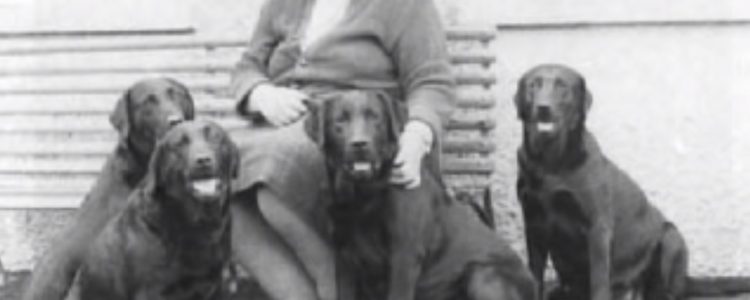
Mary Roslin Williams of Mansergh Gundogs
She bred Labs, she hunted over Labs, she competed with Labs and she taught about Labs. She had seven generations of champions, and 15 or so dogs who won field trial awards.
In the early days, she lived in Mansergh Parish, just south of the Lake District in England.
Mary Roslin Williams taught from practical experience and common sense.
Although she’s no longer with us, she left behind knowledge that she shared. Read a bit and then take a half hour to listen.
The start of the show/field divide
“I started this book by pointing out that at any one time there are about twenty top breeders who can and do stay at the top for many years, but when I come to the breeders who can show their dogs as Championship show-prize winners and also run them in Trials as Trial dogs, accepted as such by the Trial people and not called ‘Bl—y show dogs’ as is their wont, then I find it hard to name twenty kennels that can do this in the last forty years.
“Before the last War there were plenty of strains capable of doing this, indeed it was more or less the norm. The whole atmosphere of Labrador breeding was different, with such people as Lorna, Countess Howe seeing to it that the show Labrador remained a working dog. … The dogs were good-looking on proper Labrador lines, they were thoroughly experienced shooting dogs and cut out their own work with the minimum of help from their handlers, although always ready to take the hint when they were stuck. The good work on the day was put in by the dogs and not the handlers, and while Lady Howe was alive this happy state of affairs, when Trials were fun and you and your dogs welcome, remained until the sad day she died, when we immediately feared and experienced the Great Divide, into entirely show bloodlines and entirely Field Trial, poles apart.”
A water dog
“It’s a great sadness to me, that when they named the Labrador they didn’t call it the ‘Labrador Water Retriever’ … because we forget that the dog is a water dog.
“It’s job was water work. It’s job still is water work and we’ve adopted it and adapted it for different works. But in many countries that we sell our puppies to … they expect that dog to work in water. Very largely. And if you sell a dog to Canada it will be working in water in terrible frost. In cold water. Hours at a time. We ought to remember that, both when we breed and when we judge….
Defining type
“The next thing is the Labrador is a Labrador. Now here is a difficult thing because this is type and however much you have a standard, one thing it cannot describe is type. You’ve got to have type in your head. … Perhaps type varies a little from country to country. …
“My criterion for Labrador type is a very simple one. It must look like a Labrador. It mustn’t look like a Foxhound. It mustn’t look like a Pointer … It mustn’t look like a Golden Retriever. …
Pointer
“You get unmanageability. It’s an outward bound dog. It’s horizon is 300 yards away. It’s hind legs make it gallop because they can’t help galloping. It’s head is held too high. It’s elbow is angulated for a high head carriage and you don’t want it in a Labrador. We used to get it. And besides that we’ve always got a very, very short coat.”
Foxhound
“The Foxhounds came in deliberately. … And what came with it? Arrogance… When he went to judgment, instead of looking at you like a Labrador should – they did that (turned head away) – with the proudest, most arrogant expression. Now that got into the breed very badly, so that we had championship show judges writing in their critique … correct arrogant expression…. It’s absolutely wrong.
“And the other terrible fault we got in there was that they were very fastidious. … They did not like opening their mouths in dirty water. I can’t blame them. I don’t like opening my mouth in dirty water. And I don’t intend to which is why I have a dog…”
Flatcoat
“Now the next thing that happened was that somebody realized this and they quietly moved in a Flatcoat. Now that did a power of good. But we had a Flatcoat influence. One of the reasons why I hate a black eye in a Labrador was that was brought in. We brought in narrow heads, Flatcoat eyes. Flatcoat shaped eyes. And we had a lot of feathering….
“Labrador breeders are so sensible they can get these things out. It took some years and we left the good points in. We lost the arrogance. We lost the hardness and we got dogs that would retrieve nicely again…”
Greyhound
“Now the next thing that came in – and I don’t know where it came in – and I could never get Ronnie Hill to tell me, but what he knew was that the trial people introduced Greyhound. And they introduced Greyhound purely to get the speed.
“Now that influence is still with us. And if you look at the trial Labradors, you’ll see that a lot of them have very, very beautiful necks and shoulders. Marvelous necks. Way, way beyond our reach of neck. Really beautiful necks and shoulders. And they have the deep body, then the tell-tale arch over the loin. And that is the most difficult thing to breed out, to get the field trial arch out of the loin. And then they have long, thin tails and single coats. …
“So I’m warning you, if you use field trial lines you get the virtues, you get the faults, but worse still you get their diseases. And this is why I am so against any Labrador looking like anything – or particularly feeling like anything – when you’re judging that isn’t a Labrador. But as you get in other breeds and you will get in diseases …
“So therefore my first Labrador has been a water dog. My second Labrador, for heaven sake, let it be a Labrador and let it look like a Labrador. Let it behave like a Labrador and feel like a Labrador and work like a Labrador.”
Importance of a correct coat
“… I do wish that everybody … would remember that the Labrador is a cold, wet weather dog and that he’s a water dog. And that it should be able to go out duck flighting in January in bitter, bitter weather sitting at the bottom of a cut in the sand with water up to its belly or even up to its neck. The tide coming in or out and it has to sit there for while the duck flighting in. A it is cold and it is wet and the dog must be able to stand it.
“…Please remember that that is the job of a Labrador. And they should have a proper coat. And it should coat them all over. [Some dogs] are half coated. They have a hard, hard ripple like a table runner down their backs. Very, very hard hair and they have nothing else. … And that is not a Labrador coat. The Labrador coat should cover all over to the same depth and be dense, but they’re very, very difficult to find now…
Why correct structure is important
“… a Labrador’s job is not to hunt in front of you, flushing rabbits, flushing pheasants, however good.
“It is not to be a guide dog for the blind.
“It is not to be a dog for finding drugs or any of these useful things [like] finding … a dead body… That’s not it’s job.
“It’s very nice of it to do it… but it is not it’s job.
“It’s job is to sit or walk at heel until told to go. And it’s only told to go either at the end of the drive or when the bird comes down if you’re in … a duck blind … and you want it to go. …”
A level back
“And for that you need a dog bred on exactly classical lines. And a classical line is a level back, not a rake. A level back. Any retrieving dog that has to also mark should have a level back. …
The neck
“It should have a longer back to its neck than to it’s throatline. … It should have an 11″ back to its neck and a 4″ throatline, not an 11″ throatline and 4” back.
“If it was a horse it would be putting it’s ear in your mouth…
“It’s very dangerous for a Labrador to have that enormous exposed windpipe… And then when they pick their bird, it stands to reason that… the long line is on the top and the short line is underneath.
The shoulders and angulation
“Now the shoulders should be laid back and this is very important too.
“In a pointing setter, they have a laid back shoulder. Fair enough. But they don’t have the classical right angle at the point of the shoulder. They are over angulated… We want the right angle or thereabouts give or take a few degrees.
“If you have a laid back shoulder, a right angle there and a level back … the foreleg comes back under the girth. It’s not under their ear and neither is it straight under the point of the shoulder. It is back and the elbow is under the girth.
“So there you have the exact angulation that the dog can easily mark the bird when he’s walking because it’s easy for him to have his head up. He can get a scent within a reasonable distance… and then put his head down. And he can get his head down perfectly easily without having to put his elbow out… So therefore you’ve got a perfect mechanism there.
“And he must have that long line on the top of his neck to pick his bird. He then picks his bird – which takes a lot of strength – and gets it back onto the layback of his shoulders easily carrying it on the layback of his shoulders.
“So if you have the classical front, that is exactly right for a Labrador, a Golden, a Flatcoat, a Curly, a Ches, but it isn’t right for a Pointer and Setter. And it isn’t right for a Foxhound. They have their own fronts, slightly open.
An example of why it matters
“… if you have an over angulated shoulder with open angles, like a Pointer and Setter – I’m citing one of my own dogs now.
“I had a lovely dog name Tarmac … and a very good worker. But I can cite him because he was wrongly made.
“He had a marvelously erect shoulder. He then had a raked back. And the consequence was that he was over angulated behind so that he had too much stifle and too much hock – too long a hock – and it was too far behind him. And that is what happens when you get a raked back.
“Now that was the most rightful inconvenience to him when he was swimming because he swam like a Pointer. …
“He was all right once he got the bird in his mouth, but when he didn’t have a bird in his mouth the fact that he didn’t have a level back and that he had an over angulated hind legs…, he had difficulty in the water work. So I know from experience that is not a good thing. …
“At one time because we had a craze for very, very short backs – which … is not short coupled, the word ‘short-coupled’ means the loin. … they were absolutely cramming dogs so close together that they had no where to put their feet when they ran. .. They were crabbing and they had a very short line … from the point of the hip to the point of the buttock, they had no rumps whatsoever.
“And I am quite certain for work – particularly swimming – you must have a decent balanced length from the point of the hip to the point of the buttock. …
Stance
“Now if you’ve got your backline right, then you’re going to have your angulation just about right.
“And it’s well to remember – again – that a Labrador is not meant to stand with it’s legs out behind it like a Pointer or a Setter. They’re meant to stand more or less under the point of the buttock. “In other words the dog is standing slightly over his leg and he mustn’t stand sickle-hocked with his feet too far forward.
“And a very important point, … for a perfectly balanced dog … from the hock to the ground … should be at exact right angles to the ground – not stretched out back, nor sickle underneath. …
“If that dog drops it’s hock correctly, then it is standing absolutely correct on it’s feet and you’re less likely to have foot trouble.
“… If you’ve got your angulation right and your level back, you’ve got a balanced dog standing on it’s feet correctly with it’s weight very, very slightly on it’s hocks … and it should stand in a position … that it could jump in any direction immediately. It can either jump forward or backwards or to either side because it’s slightly on it’s hocks.
“Those, to me, are the salient points of a Labrador’s conformation. …
“And besides that, …it has to have a tender mouth and the ability to retrieve, the ability to mark and a thousand other things that you have in field trials and it’s like trying to get your football pools right. You’ll never do it, but we try.”
# # #
For a fun walk down memory lane, read some reminiscences from MRW’s daughter, Anne.
Would you like to learn even more? MRW wrote two books – and although they can be hard to find and expensive – they are worth the effort.
Advanced Labrador Breeding (aka Reaching for the Stars)

This is a story about two Lab puppies that were very special dogs.
The best place to start is at the beginning…
I heard about a daughter of River Oaks Way-Da-Go Rocky that was for sale. She was field-bred, but looked like a classic Lab with a broad head, good angles and plenty of bone.
It was a no-brainer. I had to bring her home.
Dee was wonderful in the house – clean, quiet and she fit right in. In the field, she was dynamite. She was focused, fast and so easy to run.
She was the first dog I ran in hunt tests. She started in four tests and titled in four tests. In hindsight I should have run her in the next level as well.
But then she came in season and I bred her to my very talented chocolate boy, Chip.
I was hoping for a chocolate female puppy.
The birth of two Lab puppies and their siblings…
The first four puppies came out every 30 minutes like they were on a timer – boy – boy – boy – boy.
Then we waited. And waited. An hour went by. Two hours. Three hours.
It was so long since the last puppy and there were no more signs of contractions. I thought Dee must have finished whelping so I started putting away all the whelping supplies.
I was so sad not to get my chocolate girl.
A happy surprise…
Then FOUR HOURS after the last puppy was born, she had another puppy.
A boy. Jeez Louise!
Shortly after that she had two more puppies – a black girl and a chocolate girl!
Meeting my heart dog…
The story doesn’t end there though. I was so happy to get the chocolate girl I’d wished for, but there was another puppy. Every time I cleaned the whelping pen or interacted with the puppies the black girl paid attention to me. She had fabulous eye contact!
The more I got to know her, the more I fell in love.
She was Arwen. My heart dog.
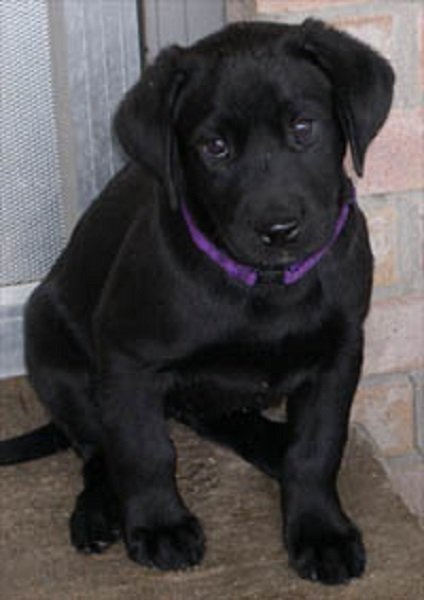
The story doesn’t end there however…
The first born boy became my husband’s favorite. I think he liked him for the white star on his chest.
He promised he would train him and take him to work with him. It didn’t happen so I put the puppy up for sale. I got several good offers for him, but I couldn’t do it. I’d fallen in love with him too.
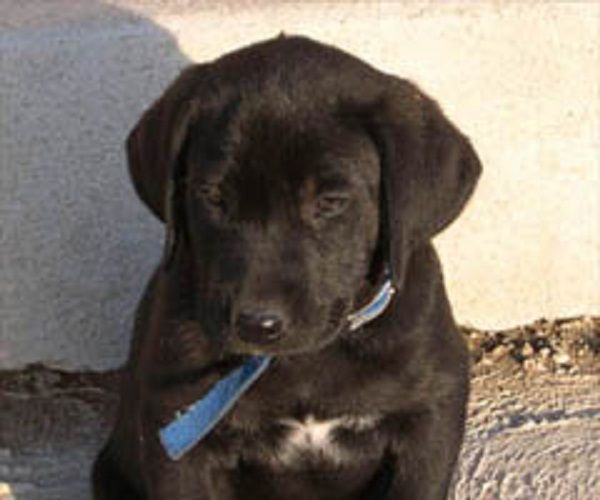
He was Tory. Another heart dog.
The two Lab puppies grew up…
Tory grew to be a big, impressive male with a deep bark. Often he would sit in the car watching as I went in a store. When he saw me come out, he would woof. Just once and just loud enough for me to hear.
He earned four Rally titles in 29 straight runs with a perfect score and several placements. He enjoyed competing.
Tory also competed in hunt tests – both AKC and HRC. He was on the verge of completing his Hunting Retriever Championship title when he collapsed. I rushed him to the veterinarian who said his heart was failing. She gave him a few weeks to live.
He made it nearly six more months and didn’t show any signs of a heart problem. To be safe, he didn’t run in any more field events and lived a happy, but quiet, life.
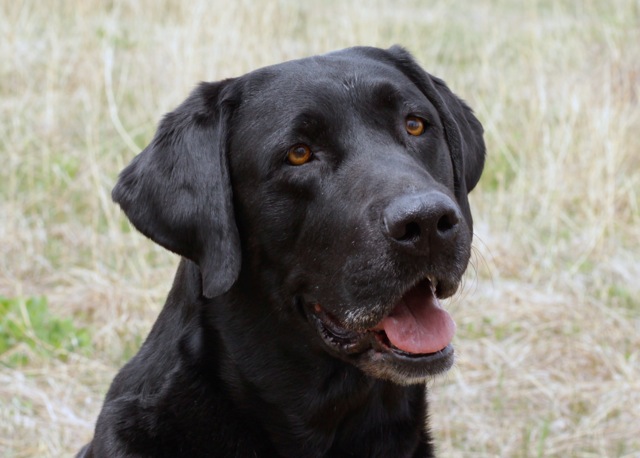
Arwen was smaller than her brother, but she was the alpha. Tory was the enforcer and kept the other dogs in line. One day he thought Arwen did something wrong and he trotted over to set her straight. She just turned and gave him “the look.” It was comical to see that big dog do a reining horse slide stop and then tip-toe away from her.
She was multi-talented and competed successfully in several venues – hunt tests (AKC and UKC), obedience, Rally and Barn Hunt. In addition to titles, she also earned special awards. At the Labrador Retriever Club national specialty, she received the Dog For All Reasons award. She was the third dog to earn the LRC’s Versatile Producer of Merit award. Arwen also received awards such as a Multi-Purpose Retriever and a Retriever Achiever.
However her most important roles were as my shadow, my sidekick, my confidant, and my friend.

Not an ending…
These two Lab puppies and their dad, Chip, were my Musketeers, my constant companions and my teachers. Anything I asked, they tried.
Someday there will be a joyful reunion at the Rainbow Bridge.
Two Lab puppies:
HRCH UH Justamere Arwen CD SH RE RATN CGC CC
HR UH Justamere Aviator CD SH RAE CGC CC
Sire:
HRCH Justamere Chocolate Chip CD TDX SH RAE CGC
Dam:
Knight’s Tail Dehlia JH


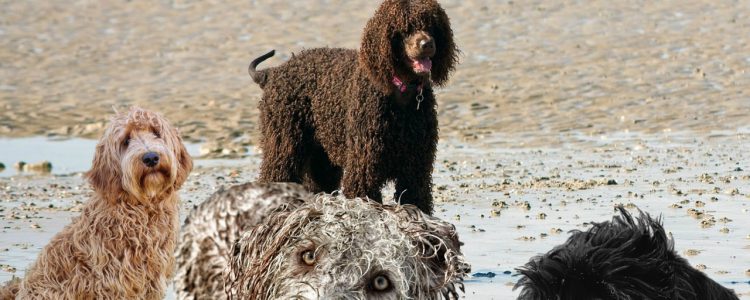
Learn about LabraDoodles – what they are, their good points and their bad points – before you go see a litter of puppies.
They’re not purebred
Despite what some people might say, a LabraDoodle is a crossbreed, just like the so-called “Silver Labs.”
It’s a marketing ploy. They slap a cute name on something (like “LabraDoodle”, “Puggle” or “Poochon”) and charge a high price to make you think it’s special or a “designer” breed.
What they are is a cross between a Poodle and some other breed, such as the Labrador Retriever.
Unfortunately when you cross two different breeds, you get a mish-mash of genes.
Mixed genetics = lots of unknowns
They don’t come out the same way each time. It’s unpredictable – looks, coat, behavior and health.
You might get a puppy that looks like a Lab, but acts like a Poodle. You might get a tall one or a short one.
It could have a coat that’s wiry or soft, or curly, wavy, or straight. Many doodles do shed and some need to be shaved every 6-8 weeks.
The good, the bad, and the ugly
The good
LabraDoodles and other Poodle crosses can be adorable. So cute and fluffy you want to cuddle them.
Each dog is unique. Some might get the Poodle coat while other dogs have a Labrador coat. Same with temperament.
The bad
You don’t know what you’re getting. One Doodle might have a Labrador temperament, while another is more Poodle-like.
Owners are often surprised to find they are allergic to their dogs
You may also get a puppy that inherited the genetic problems or diseases from BOTH breeds.
Or you might get poor temperament despite the docile Lab temperament that is often advertised.
LabraDoodles tend to be noisy. Some LabraDoodles are high-strung and may not be good with children.
They can also be needy and crave attention which makes them a poor choice if there is no one home during the day.
Depending on the size of the Poodle parent, Doodles can be small-ish or can be 80-pounders.
All of them need special grooming. It’s not bad if they got the coat of one parent or the other, but some might have a mixed coat.
Many groomers refuse Doodles, but for the groomers who do accept them expect to pay $125-200 for each session.
Some boarding kennels refuse them.
You’ll need to brush them often and make regular grooming appointments. Start this while they are still puppies or you might not find a groomer willing to work on your dog.
If Doodles aren’t groomed every week – down to the skin, not just the surface fur – they may need to be shaved. Dogs don’t like this. Groomers don’t like this.
The ugly
Without proper socialization and training, LabraDoodles can be terrors. They can scream and bite.
They tend to be mouthy, so provide plenty of chew toys.
And, yes, it can get ugly when they get lonely or bored.
Pulling back the curtain
After paying 2-4 times the cost of a purebred Lab or Poodle, owners sometimes dump them at shelters. Too often it’s due to aggression towards children.
“Designer dog breeds that most end up in shelters are poodle mixes [like] labradoodles, goldendoodles, [and] cockapoos). It’s mostly because they are adopted by busy owners who are not ready for their high energy levels” according to AZ Animals.
Because of the high price people are willing to pay, Doodles are the “breed” of choice for many puppy mills.
The man credited with creating them said he regrets introducing this mix-bred dog to the world. He was trying to breed a guide dog that was also hypoallergenic, but he failed over and over.
I opened a Pandora’s box, that’s what I did. I released a Frankenstein. So many people are just breeding for the money. So many of these dogs have physical problems, and a lot of them are just crazy.
In a nutshell
If you want a LabraDoodle, do your homework. Meet the breeder and the parents of the puppy you’re considering buying. Check temperament and trainability. Check for health certifications.
When your puppy is old enough, enroll him in a Puppy Kindergarten class. It’s good for basic training and socialization.
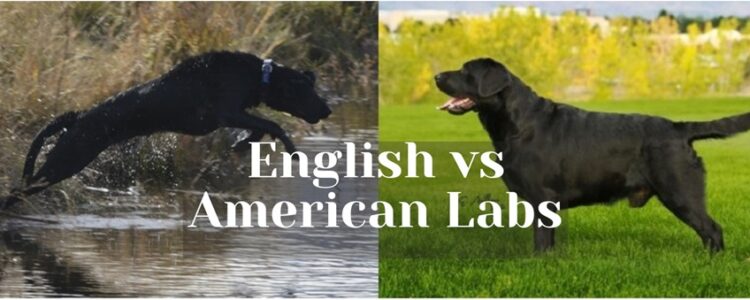
As a long-time Labrador fan, I’ve owned both the English vs American styles. Some people call them “show” or “field” Labs, as that can be less confusing.
So, what makes one dog an English Lab and another an American Lab? This guide will explain what happened.
Early Labradors in America
From the 1930s when the first Labs were imported through the 1970s, field Labs and show Labs were virtually the same. It was common for show dogs to be bred to field dogs. Even Ebonstar Lean Mac, one of the best-known field trial Labs, descends from show dogs.
Often, individual dogs were a bit better at one sport or the other, but some were good at both. During that time there were 37 Labs that earned both a show championship and a field championship to become Dual Champions.
What Caused The Split
In the 1970s and 1980s, a second wave of British imports began. Some of these dogs were heavier-bodied with blocky heads. Show fanciers in America flocked to them hoping to breed the next big winner.
Meanwhile, field trials were changing. The landscape here is bigger and more open than in England so dogs needed to go farther and faster to win.
Thus started the divergence. Show dogs became shorter and heavier. Field dogs became taller and lighter.
Because show dogs of that time had imported English blood, they were called “English Labs.” Originally only the imported dogs were called English, but over time all show-type Labs were called English. Other Labs were called American.
English vs American – Physical Differences
During three decades as the most popular breed in America, striking differences developed between the English vs American styles.
These physical differences aren’t just cosmetic, they reflect the different purposes for which the English vs American Labs were bred.
English Labs were bred for show rings, while American Labs were developed for their hunting and field trial abilities.
Energy level
Both English and American Labs are highly trainable, but their different energy levels can affect their training needs.
English Labs:
- Often easier to train for basic obedience
- May be more patient with children and other pets
- Good for therapy work and as emotional support animals
American Labs:
- Great at advanced training and complex tasks
- Thrives on plenty of physical and mental stimulation
- Good for active families and outdoor enthusiasts
Temperament
Both English and American Labs share the Labrador friendliness and eagerness to please. However, there are some slight differences in their temperaments.
English Labs are often calmer and more laid-back. They are great for families and first-time dog owners and they enjoy being a “couch potato.”
American Labs often have higher energy levels and are more athletic. They enjoy doing something, whether hunting, competing, or fetching a ball in the yard. They can also be great family dogs.
Different Purposes
The differences in appearance, energy level, and temperament between English vs American Labs are due to their varied purposes.
English Labs are bred for the show ring with a priority on their structure and looks. American Labs are bred for hunting and field trials where they need athleticism, stamina, and working ability.
Most Labs fall somewhere in between with traits from both types.
English vs American Labradors aren’t the only choices
Instead, it’s a continuum from short and heavy with a large head to tall and slender with a narrow head.
Some show males look more like a Newfoundland or a wrinkled Shar Pei. They are almost a cartoon version of the original Labs that were bred to be field dogs. However, I am seeing a shift to a more moderate dog in the show ring. An exception is at the Labrador-only shows where structure is generally excellent, but more-is-better often reigns.
Some field-bred females have the height, slender legs, and head shape of a Whippet. These dogs can spend all day hunting or retrieving at tremendous distances and still want more. They are often bred for trainability, marking ability, and intelligence rather than their looks.
In between, there are dogs that still look like a classic Labrador. Classic Labs are dogs from early in the breed’s history until the breed really started to diverge in the 1960s.
Here are a couple of classic Labs:
First, is Dual CH NFC AFC Can CH Shed of Arden, a great Lab of the past. He not only earned a show championship in two countries, but was also a three-time National Field Champion! Shed was not so tall and lanky as many of the field dogs of today, nor was he so blocky as most of the current show dogs.

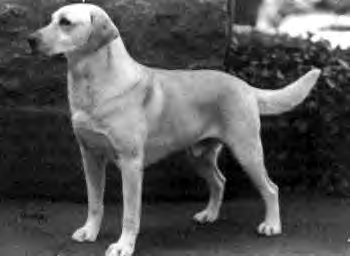
Another great from the past was CH Shamrock Acres Light Brigade. “Briggs was an outstanding show dog and sire. He produced 93 AKC Champions and won 12 Best in Show awards and 75 Sporting Group placements.” Compared to show dogs today he had longer legs and less substance, but look at those shoulders and the balance! I’d bet he moved exceptionally well.
Additionally, many people just want a Labrador and don’t breed for a specific style. The breed’s versatility and adaptability allowed it to meet many needs and yet keep it’s intelligence, friendliness, and trainability.
Choosing the Right Lab for You
When choosing between an English vs American Lab, consider your lifestyle and what you’re looking for in a dog.
- Activity Level: Do you want a more laid-back dog or an energetic exercise partner?
- Living Space: Do you have a large yard or live in an apartment?
- Time Commitment: How much time can you spend training and exercising?
- Family Situation: Do you have young children or other pets?
Remember, these are general guidelines and some dogs might be different. Always meet the dog and, if possible, its parents before deciding.
You can also check out the AKC Breed Standard to read about the “perfect” Labrador.
The differences between these types of Labs allow dog lovers to find a Lab that fits their lifestyle. Whichever you choose, you’ll have a great companion with the qualities that make Labradors one of the most popular breeds worldwide.

Banchory Bolo was the first-ever Dual Champion Labrador Retriever.
His is an interesting story. Not just rags to riches, but riches to rags and back to riches. Pull up a chair and learn about the dog who still has an influence on Labradors over one hundred years after his birth.
Bolo’s early years
Bolo was two years old when Mrs. Quintin Dick (later Lorna, Countess Howe) entered his life. She had owned his sire, Scandal of Glynn, who was “a charming and beloved companion and a great game-finder.”
When Scandal died, she wanted to find a dog to replace him. Unfortunately, none of the other dogs she owned could fill the gap his passing caused.
Her husband, Quintin Dick, suggested a son by Scandal. However, during the First World War breeding was restricted and Scandal had only sired one litter. In it, there were 13 puppies of which 12 were females.
The only male – originally named Caerhowell Bully – had been given away by his breeder. When Lorna(1) found him, he was given to her with the advice that if she didn’t want to keep him to have him put to sleep. They told her the dog was “hopeless” and had “an evil temper.”
When she picked him up at the train station, she realized what she’d been told was true. The dog was unkempt, had sores on his ears and he growled at her through the heavy muzzle he wore. Although he had a wonderful pedigree, she debated: Should she keep him or put him to sleep as she’d been advised?
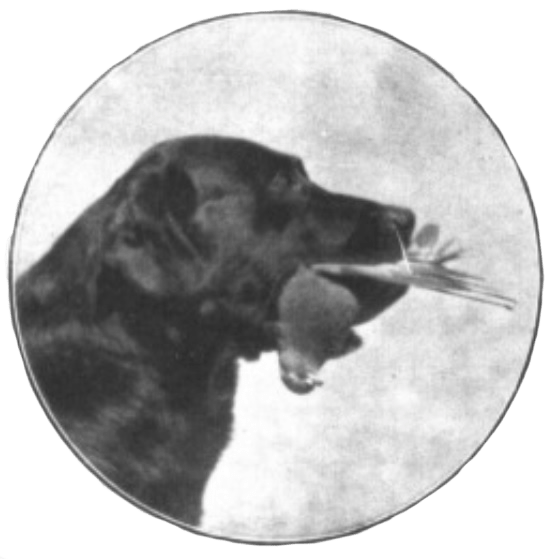
Banchory Bolo
Lorna and Bolo
She must have had a kind heart as she took him home with her. After taking off the muzzle and chain, she turned him loose in a spacious room, but he was distrustful and surly. He wouldn’t come to anyone and it took quite a while to catch him.
Something must have happened to him in his earlier life. Heavy-handed trainer? Malicious kennel help?
He avoided people. When turned out for exercise, he was hard to catch. How could he be trained when he was so distrustful of people? What could soothe the savage beast?
It turns out it wasn’t music, but Lorna’s gentle care. When he became seriously ill, she nursed him back to health. During that time, he realized she was someone he could trust. As he recovered he became devoted to her and was always at her side.
The stirrings of greatness
When he started in training, Lorna found he had “a natural love of retrieving, an excellent nose, and a perfect mouth.” However, he also had two failings: he loved chasing rabbits and was terrified of cracking whips. One day when a stable boy happened to crack a whip near him, the fear took over and Bolo blindly sought escape. A tall, spiked gate didn’t stop him from running.
He returned early the next morning, covered in blood. “He had two very deep wounds on his chest, a tear three inches long in his groin and his hind leg and hock torn so badly that the bone was visible.” Because a veterinarian was too far away, Lorna stitched his wounds as he lay still for her.
Her doctoring and subsequent training was well done as the next fall he won a field trial prize. Then he quickly won two field trials and became a field champion. Two years later he also finished his show championship and became the first Dual Champion Labrador.
Lorna said, “He had quite the best nose I have ever seen in a dog and with apparently the greatest ease he would collect runner after runner after several other dogs had failed. I have never had a dog with such great natural ability or one so anxious to please me in every possible way.”
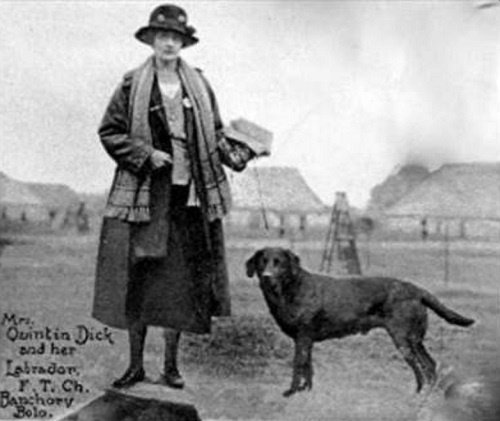
Lorna, Countess Howe and Banchory Bolo
From greatness comes greatness
The genes from several great dogs came together in Banchory Bolo. We have Lord Malmesbury, the Dukes of Buccleuch, and Lord Knutsford (Munden kennels) to thank for their breeding insight and the dogs they produced.
Banchory Bolo’s pedigree:
| Scandal of Glynn | English FTCh Peter of Faskally | Waterdale Gamester |
| Birkhill Juliet | ||
| English FTW Shelagh of Glynn | English FTW Scamp of Glynn | |
| Shelagh of Danesbury | ||
| Caerhowell Nettle | Foxley Kennett | Hirsch’s Ranger |
| Bendysh Bess | ||
| Baker’s Nora | unknown | |
| unknown |
His family
Looking backward in time, Bolo’s sire, Scandal of Glynn, was a son of English FTCh Peter of Faskally. Peter won the International Gundog League’s Championship Stake for retrievers in 1911, but it was his partnership with his handler, Archie Butter, that set him apart from the other retrievers.
Butter realized that if a dog could be guided by his handler, the quicker he would be able to find and retrieve game. To do this, he adapted the methods used by shepherds when handling their dogs using whistles and hand signals. We still use a form of this method today.
Peter of Faskally’s pedigree is filled with dogs from the Munden and Buccleuch kennels. Munden Sixty (born 1897) appears three times in Peter’s pedigree and once more in Scandal of Glynn’s maternal line.
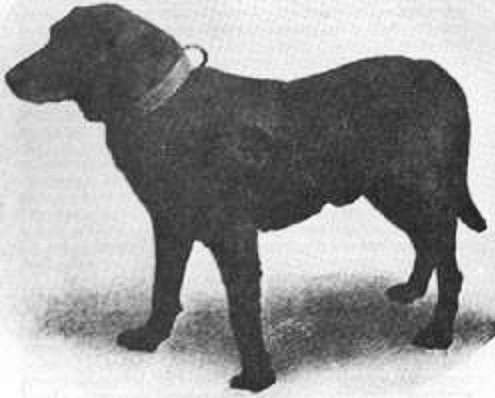
Buccleuch Avon
Sixty’s paternal grandfather, Buccleuch Avon (born 1885), was a gift from the third Earl of Malmesbury to the sixth Duke of Buccleuch.
Avon was sired by Malmesbury Tramp (born 1878) and out of Malmesbury Juno (born 1878). Another male, Buccleuch Ned (born 1882), was also a gift. These dogs were bred to bitches that descended from dogs imported originally by the fifth Duke of Buccleuch.
Another great in Peter of Faskally’s pedigree is Munden Single (born 1899). She was sired by Munden Sixty and descended from Munden, Buccleuch, and Malmesbury dogs. She’s best known for being the first Labrador to win a Challenge Certificate and the first Labrador to run in a field trial.
More Munden, Buccleuch, and Malmesbury
Less is known about Scandal of Glynn’s maternal side. His maternal grandfather, Scamp of Glynn FTW, traces to Buccleuch Ned, the other male gifted by Lord Malmesbury. And his maternal grandmother, Shelagh of Danesbury, is mostly from Munden dogs that trace back to the Buccleuch and Malmesbury kennels.
Even less is known about Banchory Bolo’s mother, Caerhowell Nettle, although her father traces back to Peter of Faskally as well.
Bolo’s legacy
With all the good genes passed down from his ancestors, it’s not surprising that he also produced well. He sired both show champions and field trial champions.
Bolo’s show offspring
In 1921, he was bred to Brocklehirst Nell (owned by Mrs. Dinwoodie) and sired English Ch Banchory Bluff, English FTCh Nith of Halleaths, and Brocklehirst Daisy FTW. Bluff was the maternal grandsire of English FTCh Balmuto Hewildo. Bluff was owned by Lorna.
Also in 1921, he was bred to Murrayfield Bett (owned by Mr. Dinwoodie) and sired English Ch Brocklehirst Donner. This dog was also owned by Lorna.
Yet another litter in 1921, produced English Ch Beningbrough Tangle. He finished his show championship, including winning the CC at Crufts in 1930 and he also won a field trial. So close to being another Dual Champion! He was bred by The Earl of Chesterfield and owned by Lorna. His mother was Thyme, a daughter of English Ch Ilderton Ben.
In 1922, Bolo was bred to a granddaughter of English Ch Ilderton Ben. Her name was Malta of Lunn and was owned by the Earl of Clarendon. In this litter was a female named English Ch Banchory Kelpie, owned by Lorna.
Breeding dogs all but stopped during World War I. This sent the Munden kennel to the edge of extinction. However Lorna “gave Lord Knutsford a puppy on the condition that he should eventually breed her with Dual Champion Banchory Bolo.”
He registered this puppy as Munden Scarcity. Her sire was English Ch Banchory Lucky and her dam was Banchory Betty. In Scarcity’s litter by Bolo, she produced both English Ch Banchory Danilo FTW and English Ch Munden Solo FTW. Lord Knutsford also kept Singer, a bitch, and another bitch was given to His Majesty the King.
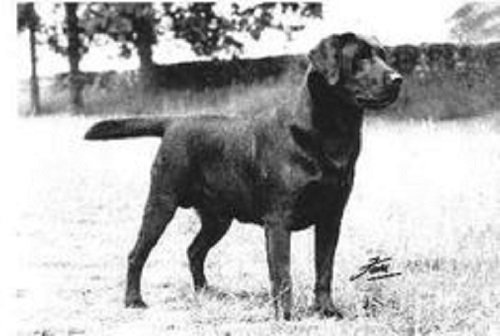
Banchory Danilo
One of Bolo’s best sons
Danilo won 33 Challenge Certificates in the show ring and won the best exhibit in the Kennel Club Show in 1925. He went on to also win two field trial honors in 1924, handled by Lorna. Danilo sired English Ch Drinkstone Pons of Wingan (sire of American Ch Echo of Arden), English Ch Drinkstone Dan, and Haylers Danilo (sire of English Ch Poppleton Black Lancer).
When Danilo’s grandson, Hiwood Risk, was bred to Peggy of Shipton we see some of the Arden dogs, including American National Field Champion Tar of Arden and her offspring – American FC Firelei of Deer Creek, American NFC Black Magic of Audlon, American Dual Ch CFC Little Pierre of Deer Creek.
Danilo’s brother, Munden Solo, also did well at shows. At Crufts in 1927, he competed in ten classes, won six, and placed in three more. The judge wrote of him, ‘If there had been a little more of him in size, I think he would have been very near perfection.’
Bolo sired another English show champion, Banchory Bolo’s Trust, in 1926. His mother was Beaulieu Nance (daughter of English DUAL Ch Banchory Sunspeck).
English DUAL Ch Bramshaw Bob, double-bred on Bolo, won Best in Show at Crufts twice – 1932 and 1933. Lorna bought him from Sir George Thursby and when she took him to Crufts in 1932, Bob won all the classes he was entered in and won Best in Show on the second day.
Lorna said, “Cruft’s Show was, and still is, a great meeting place for gamekeepers. I shall never forget the overwhelming reception they gave Bob when the award was announced; it was so kind of them. They were pleased that a working gundog should receive this much-coveted award.”
Bolo’s field offspring
Bolo was bred to Kirkmahoe Dinah FTW in 1921. This litter included English National FTCh Kirkmahoe Rover, Banchory Corbie FTW, and Choice Of Kirkmahoe FTW.
Banchory Corbie won one Challenge Certificate (show points) and won the 1923 International Gundog League (IGL) Nomination Stake. Then he “broke his shoulder by galloping into a guard post” thus ending his show and field trial career. Lorna described him, “Corbie was in character and temperament all that a Labrador should be. He was highly intelligent, very faithful, a wonderful watch-dog and guard, yet very gentle with children. He had the great game-finding ability which goes with good nose and the brains to use it.”
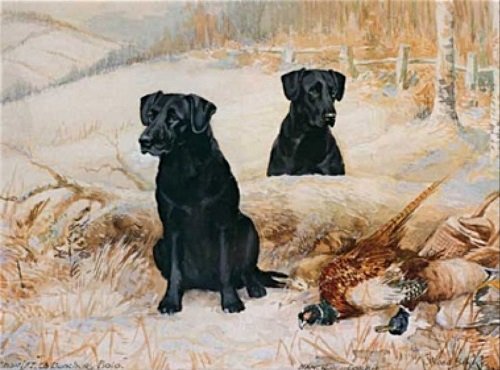
Banchory Bolo and his son, Banchory Corbie
Another Bolo son was born in 1923, Banchory Roger FTW. He was linebred on English National Ch Peter of Faskally and on Munden Sentry.
Another male, English FTCh Balmuto Hewildo, was also double-bred on Bolo. Instead of winning in the show ring, he won the IGL Retriever Championship in 1936. This is comparable to the National Retriever Championship in the US.
In short, Bolo was a great producer.
A legend
Author C. Mackay Sanderson wrote, “Bolo’s coming may be said to have breathed a spirit of new life into the breed, the prestige enjoyed by this dog as a competitive and stud force giving lasting impetus to Labrador fortunes and subsequently his name runs like a golden thread through all the vital streams of progress.”
“The Field wrote of Bolo: ‘If ever evidence were needed of the character of a great dog, and of his influence on the generations following him, it was to be found at the Retriever Championship Trial held at Idsworth last week [December 1932]. Out of fourteen dogs that won prizes, eight were descended from Banchory Bolo.'”
But Bolo also had another legacy – he tended to throw white hairs on the feet. These ‘Bolo marks’ or ‘Bolo pads’ are still sometimes seen on the bottom of the front feet and/or the back of the front pasterns.
Bolo died in July 1927. It was ten years before Lorna was able to give her heart to another dog.
English Dual Champion Banchory Bolo
Whelped: December 29, 1915
Died: July 10, 1927
Owner: Lorna, Countess Howe (AKA Mrs. Quintin Dick)
Breeder: Sir John S Harmood-Banner
Original name: Caerhowell Bully
Registration: KC SB 218AA
1. Although she became Lorna, Countess Howe because of her second marriage, she was known as Mrs Quintin Dick during Bolo’s lifetime. However for the sake of ease, I’ve used her first name here as it’s how she’s known by Lab enthusiasts worldwide.
Abbreviations:
Ch – Show champion
CC – Challenge Certificate (show points)
FCh – Field trial champion
NFCh – National field trial champion
FTW – Field trial winner (not a title)
CFC – Canadian field champion
IGL – International Gundog League
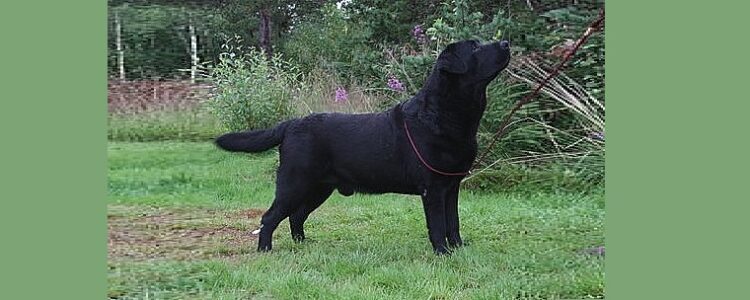
Dickendall Peacekeeper was nicknamed “Chuck” after Chuck Norris, the actor and martial arts expert. Like Chuck (the person), Chuck (the Lab) was sweet and mild-mannered until it was time to go to work – then watch out!
He finished his Junior Hunter title with style and was working on his Senior Hunter title when his handler had a health issue and wasn’t able to finish his title.
Instead, Chuck went globe trotting and spent over a year in Finland where he was popular with the ladies. He is now retired.
Chuck was bred and owned by Dickendall Labs.
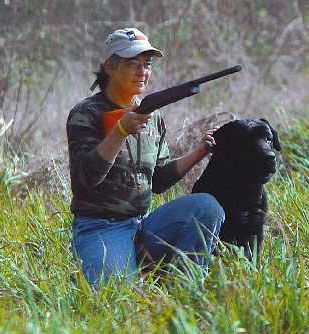
Below is a photo of Chuck’s father, Morgan. He was imported from Europe where he often won in dog shows.
According to Morgan’s owner, “He has 3 CC’s and 2 CACIB’s from Holland, 2 CC’s and 1 CACIB from Finland, 1 CC and 1 CACIB from Sweden and 1 CC from Italy, and several BOBs. He gained the NLV CW’99 title, when winning the dutch Bennekom Club Show out of 800 labradors. He is also Nordic Winner ’99.”
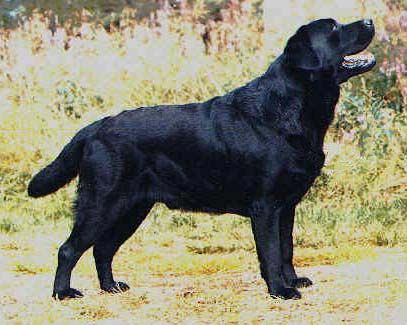
Chuck’s clearances and pedigree:
Hips OFA LR-145035 Good
Elbows LR-EL23955
Eyes CERF: LR-40971
| Dutch CH Trendmakers Tycoon “Morgan” |
Swedish Danish Nordic CH Trendmakers Mugwump | Beechcroft’s Royal Standard |
| Guideline’s Manuscript | ||
| Trendmakers Traffic Jam | Smart Fellow’s Order From New York | |
| Blondella Balanced Shades | ||
| Dickendall Davaron Peaceful | CH Dickendall Arnold | CH Dickendall Ruffy SH |
| Dickendall’s A-Ha | ||
| Pucketts Ping Pong | Follytower Man O’War | |
| Dickendall H Of Criner Hills |
His legacy
We had one of Chuck’s very talented daughters, SHR Justamere Jazz Singer CD JH RE CGC WC CC, or Jazzy for short. Jazzy loved retrieving and snuggling on the couch. She gave us another generation of talented Labradors.
Jazzy’s brother, Jack, was also a very accomplished Labrador. His full name with titles is SHR Justamere Jack O’ The Green RAE JH CC.
Two of Chuck’s sons finished their championships – CH Buckstone Surviv’n On Ayr “Martin” and Ukn CH Mallorn’s Madmax.
Other dogs sired by Chuck include:
Banbury’s Sweetest Taboo
Brooks Major Decision
Brooks Here To Start The Party At Countryhaven
Hightide Snowworry Just Chilln
Whispering Pine’s Bewitched

Bringing your new puppy home is such an exciting time, but are you ready? Puppies need care and a lot of attention. It’s up to you to provide a safe environment. Check your house and buy your supplies before you bring your puppy home.
Here’s a checklist to help you get started!
Preparation
Schedule an appointment with your veterinarian for a day or so after you’re scheduled to pick up your puppy.
Identify an emergency veterinarian as not all vets are available at night or on weekends.
If needed, find a reputable day care, puppy class and/or trainer.
Determine where the puppy will sleep, preferably in a crate to start.
Determine who will be primarily responsible for feeding and caring for the puppy. As the puppy starts to learn commands, be sure everyone uses the same command to not confuse the puppy.
Getting your house and garage ready
Safety first! Get down at your puppy’s level and search for everything that could be potentially dangerous and for anything you don’t want chewed. Also be aware of anything your puppy could jump or climb on to reach higher.
Check every room in your house plus the yard, garage and any other buildings your puppy might be able to access.
In the house:
Check behind any furniture where your puppy could hide and block it off. Block access to under beds.
Protect electrical cords, TV and computer cables and electrical outlets. It’s very common for puppies to chew on wires, but it can be deadly. Don’t forget about remote controls.
Keep shoes and clothing picked up or behind closed closet doors.
Place all medication and supplements inside a cupboard well out of reach of your puppy’s best efforts. Those bottles might be “child proof”, but they won’t last long against puppy teeth.
Store all cleaning supplies in a cabinet secured with a cable or in a high cabinet that the puppy can’t climb. Don’t forget to put bars of soap, bottles of shampoo, makeup, razors, cotton balls, tissues, aftershave, perfume, etc out of reach.
Secure all trash containers with a puppy-proof lid or inside a cabinet.
Store decorations, candles, plug-in scented sprays out of reach or in a secured cabinet.
Store office supplies such as rubber bands, staples and paperclips in drawers or a secure cupboard.
Keep cigarettes, cigars and loose tobacco out of reach of puppies.
Check for toxic plants inside – and outside – of the house. Move them safely out of the puppy’s reach. Check for plants are poisonous for dogs.
If you have cats or other pets, move the litter box where the puppy can’t get to it.
Don’t forget to check every closet or cubbyhole.
If there is an area that just can’t be puppy proofed, use a quality baby gate and/or an exercise pen to keep him out.
Be vigilant about keeping everything put away, out of puppy’s reach.
Garage and yard:
Check for holes in or under your fencing and anything your puppy could climb in, on or under.
If you have a deck, place a barrier so the puppy can’t fall off or down the stairs.
Move all paint, pesticides, rodent poisons, cleaners, chemicals, bug spray, fertilizers, etc out of puppy’s reach – at least five feet off the floor – or in a secured cabinet.
Store tools and power equipment out of puppy’s reach.
Do the same with antifreeze, fuel and other car fluids. These may taste sweet to a puppy, but they are deadly.
If any trash cans don’t have a secure lid, place the can in a secure cupboard or out of puppy’s reach.
Check for plants that could be potentially toxic to your puppy using the link above. These items are also toxic:
- pit fruits such as apricots, cherries, peaches, plums and avocados
- garlic, onion and chives
- grapes and currants
- chili peppers
- lemons, limes, oranges and grapefruit
- potatoes and tomatoes
- rhubarb
- tobacco
- coffee grounds and tea bags
Move or place a puppy-proof barrier around any toxic plants.
Check everything a second time a day or so before you welcome your puppy home.
Safety products
Now that you’ve found potential trouble spots, here are some products that might help.
Electrical:
For some reason, puppies are attracted to power cords. They’re small enough to fit in their mouths, easy to chew and potentially deadly.
Clear Electrical Wire Protector (Total 30 Feet)
Wire Loom Tubing To Protect Wires from Pets
Outlet Covers 38-Pack White Child Proof Electrical Plug Covers
Electrical Outlet Cover Box Childproof Large Plug Cover (Transparent)
Dual Fit Outlet Plug Cover White 2 Count
Securing cabinets and other areas:
Child Safety Strap Locks (10 Pack) White/Gray
Under Bed Couch Blocker for Pets 8 Pack 4.7″ High 126″ Long
Mom’s Choice Award – Metal Baby Gate, 29-48″ Extra Wide Pressure Mounted
Banister Guard Child Safety Net – 15ft x 3ft tall (white)
Outdoor Deck Rail Safety Net – 16ft x 38″ tall (black)
Puppy supplies
After safety-proofing your house, what do you need for puppy?
Health:
Pet Thermometer Waterproof Fast and Accurate Measurements
Disposable Probe Covers for Thermometer, 50 Count
Pet Infrared Ear Thermometer for Dogs and Cats, Rechargeable ℃/℉
Collars and leashes:
If you must add tags to your puppy’s collar, tape them flat to the collar. Dangling tags can be caught in heat/AC vents, openings in crates and many other narrow openings. When that happens dogs will often fight against it and may twist to the point of strangulation.
Also, if you have more than one dog and they like to play – especially if they grab each other by the neck – remove the collars. Too many dogs have died of strangulation when they caught their lower jaw in another dog’s collar. Both will struggle and twist. And it happens fast. I had it happen. Both dogs wore quick-release collars, but one twist and one dog was choking while the other dog fought to get free. Had I not been 15 feet away when it happened, at least one dog would probably have died. My dogs no longer wear collars except when competing, however they are all microchipped.
Unless you have a short nose dog like a Pug or a dog with a slender head like a Greyhound, avoid using a harness. Harnesses can be hard to fit and a poorly-fitted harness can cause chafing or allow the dog to slip out. It should also be taken off when the dog doesn’t need to be on leash.
Reflective Multi-Colored Stripe Adjustable Dog Collar, Violet and River Blue, Medium, Neck 14.5″-20″
Avoid retractable leashes – “flexi-leads” – especially for puppies. More accidents seem to happen with these leashes. Even a small dog running toward an attraction can hit the end of the cord and snap the clasp or collar. When that happens the cord will quickly retract and possibly hit you or bystanders causing “broken teeth, due to the collar or metal clasp breaking and swinging back into your face.” Grabbing the cord or having it wrap around a hand or leg can lead to deep cuts and even amputation.
This is a better option than a flexi-lead. It adjusts to 3 lengths: 4, 5 and 7-1/2 feet. Clip it around your chest, waist or shoulder to free your hands. It’s available in a variety of colors.
Adjustable Dog Training Leash | Secure & Non-Slip Rubberized Nylon Grip Hands Free Dog Leash (Black)
Bowls:
I have some of these bowls. They’re almost indestructible, dishwasher safe and don’t move around like regular stainless steel bowls.
Deep Stainless Steel Anti-Slip Dog Bowls, Set of 2, Each Holds Up to 6 Cups
Another option if you have a fast eater is this slow feeder bowl. There are several design, color and size choices.
Outward Hound Fun Feeder Slo Bowl, Slow Feeder Dog Bowl, Medium/Mini, Orange
Beds:
Reasonably priced washable dog beds, sized to fit in crates. Medium for puppies and smaller Labs 30x20x3″. Large for an adult Lab 36x24x3″. Extra Large for a big, adult male Lab 48x24x3″.
Waterproof Dog Bed, Reversible, Removable Washable Cover & Waterproof Inner Lining – Medium
Probably best to wait on introducing a quality dog bed until your puppy is house-trained and past the teething stage. Otherwise these are outstanding dog beds.
Best Friends by Sheri The Original Calming Donut Cat and Dog Bed in Shag Fur Taupe, Extra Large 45×45 – big enough for adult dog
Grooming:
This is my go-to brush for Labs. It’s great for removing dirt and dead hair and the dogs love the attention.
Zoom Groom Dog Brush, Groom and Massage While Removing Loose Hair and Dead Skin – Blue
If your dog grows a thicker coat than the Zoom Groom can get through, this rake can go deeper to remove dead hair. Just use it gently.
Ergonomic Undercoat Pets Rake, Dog Dematting Brush
For young puppies you can use fingernail clippers to just cut the sharp hook off the end of each nail. Remember to do this every couple of weeks. Be careful of cutting too deep and making the nail bleed. As your puppy matures, switch to a dog nail clipper.
Dog Nail Clippers Safety Guard and Nail File
For some dogs who have learned to fear nail trimming, here is a smooth and quiet clipper.
Dog Nail Trimmer for Anxiety Sensitive Dog, Quiet Sharpest Smoothest Dog Nail Clippers
4 Pack Dog Toothbrush for Dog Teeth Cleaning Dog Finger Toothbrush
The cleanest teeth I’ve ever seen belonged to dogs fed a raw meat and bones diet. This is likely due to the chewing involved, but also because of the enzymes in the meat. Another option is brushing their teeth with an enzymatic toothpaste.
Enzymatic Toothpaste for Dogs and Cats (Poultry)
Burt’s Bees for Puppies Natural Tearless 2 in 1 Shampoo and Conditioner
Containment:
Don’t skip crate training! It makes house training easier and will help in an emergency, such as a fire, tornado or flooding especially if you have to transport your dog or place him in a boarding kennel.
For a puppy, set up a wire crate with the divider panel positioned so he can stand up, lie down, turn around, and stretch. Don’t make it any bigger because he will likely potty in one end and sleep in the other. Gradually move the divider to give the puppy more space as he grows.
To help with crate training, place the crate close enough so the puppy can see you, but not in a busy area. Watch for when he’s starting to tire and place him in the crate so there’s less resistance. Add a puppy blanket and a toy in the crate with him.
You can get a plastic airline-type crate instead, but they don’t generally have a divider. Instead you will have to block off part of a bigger crate or buy a few crates in different sizes. There are generally used ones for sale on Craigslist and Facebook Marketplace, just be sure to clean a used crate well.
For people who cannot take their new puppy out to potty every 2-3 hours, you can set up an area with access to the outside or to a litter box or doggy lawn. Surround the area with an exercise pen and clip it to a crate to help keep it from moving around. Or use a baby gate to partition a room.
This is an excellent exercise pen for occasional use such as while traveling or attending competitions. However it’s probably not suitable for a puppy without supervision as it can be tipped over. It folds to about 24 x 30 x 3″
Foldable Metal Dog Exercise Pen / Pet Playpen, 24″W x 30″H
After a bit of training, this pen could be used for a puppy left alone for awhile. It is made of heavier construction with additional features:
- automatic gravity lock design ensures you can open and close the door smoothly and reduce the chance of your dog unlocking it
- Muffler Tube installed on the rings can minimize any noise caused by the rattling of the rods or panels
- Anti-slip silicone pads installed on the stakes and the bottom of the panels provide friction to reduce the possibility of the pen being pushed down and can prevent the stakes from scratching your floors
HomePlus Playpen Designed for Indoor Use 32″H 8 panels
Here’s a waterproof tarp for under an exercise pen – indoors or outdoors.
Heavy Duty Poly Tarp – 8′ x 10′ – 10 Mil Thick Waterproof
Puppies seem to like these grass mats more than pee pads, however they require cleaning while the pee pads can be thrown away.
Puppy Pad Holder Tray – Silicone, 24 x 24″
Super Absorbent Pee Pads for Dogs, Leak-Proof
Clean up:
Time-tested style of pooper scooper. Metal. Requires two hands – one to hold the tray and one to use the scraper or rake.
Pooper Scooper, Extra Large with Long Handle, Metal Poop Tray and Rake Set
Newer style with one-handed operation and spring-loaded clam shell pickup. Handle folds in half.
Pet Pooper Scooper for Dogs and Cats with Long Handle
Zero Odor – Pet Odor Eliminator – Permanently Eliminate Air & Surface Odors
Go Here Attractant Indoor and Outdoor Dog Training Spray
Treats & toys
First off, here are several treats and toys to avoid:
- Rope toys can be dangerous – if they’re too small, the dog might swallow it whole, ropes labeled as indestructible or cotton-blend likely contain indigestible nylon and/or polyester and, unlike other things puppies might swallow, long strands of rope can get tangled in your dog’s stomach or intestines.
- Toys small enough to get stuck in their throat are a choking hazard.
- Rawhide treats are not digestible and, if your dog swallows a large piece whole it could cause choking or an obstruction. Also they are often coated with toxic chemicals.
- Cooked bones are usually very hard and brittle. They can cause a broken tooth, cuts or obstructions in the dog’s mouth, throat and digestive system, and round bones can get stuck around the lower jaw.
- Although some people swear by Greenies, they do pose a risk of intestinal blockage and possible death despite the claim of being “highly digestible.” Instead you might try a single-ingredient chew such as pig, cow or lamb ears, duck or chicken feet, beef trachea or tendon or bullysticks. Because of their natural origins, you may want to give them as outdoor treats.
- Avoid tennis balls as the fuzz will wear down teeth, they can get stuck in your dog’s throat and strong chewers may swallow the fuzz and/or parts of a split ball which can lead to an obstruction. It’s better to give your dog a ball specifically designed for dogs and big enough to prevent a choking hazard.
Here are a few treats and chews we like:
N-Bone Puppy Teething Rings Chicken Flavor Dog Treat, 6 count bag, 7.2-oz
KONG – Puppy Toy Natural Teething Rubber – Fun to Chew, Chase and Fetch – for Medium Puppies – Pink
Multipet Plush Dog Toy, Lambchop, 10″, White/Tan, Small
iHeartDogs Heartbeat Puppy Toy – Comfort Cuddler Pillow – Dog Anxiety Toy
BoniVet Bully Stick Holder for Dogs, Chew Holder, Prevent Choking Safety Device
Food
Several years ago, factories in China added wheat gluten adulterated with melamine to pet food and treats as a cheap way to boost the protein percent. Many animals died after eating these foods. Since then other products from China, including milk, ice cream and canned coffee drinks, have tested positive for melamine. It’s probably best to avoid any food products made in China.
For other things to avoid, check out People Foods Dogs Shouldn’t Eat.
We feed Dynamite Super Premium dog food.
From their website at DynamiteSpecialty.com:
“A superior kibble free of the common allergens corn and wheat is made with fresh, hand-trimmed USDA chicken. It also contains chicken cartilage that is rich in natural glucosamine. On top of that our Super Premium contains prebiotics and probiotics to aid digestion.
“Made with minimal processing to help preserve the natural goodness of the ingredients, our small-batch recipe is not baked. Instead, we use state-of-the-art technology that utilizes a low-temperature, high-moisture extrusion. This method assures all starch is cooked and minimal damage occurs to the proteins.”
We also give DynaPro:
“Canine health depends on a thriving population of beneficial gut microbes. Factors such as stress, diet changes, chemical wormers, vaccinations, and antibiotics will cause a dog’s gut to become an unfriendly environment and will force microbes to go dormant. Dyna Pro is designed to create the ideal conditions for good microbes to come out of dormancy, multiply, and thrive so your dog gets optimal utilization of food and supplements, resulting in a vibrant animal!”
An alternative food is Purina Pro Plan High Protein Puppy Food.
Security
Kasa Indoor Pan/Tilt Smart Security Camera, 1080p HD Dog Camera 2.4GHz with Night Vision, Motion Detection for Baby and Pet Monitor, Cloud & SD Card Storage, Works with Alexa & Google Home (EC70)
Petcube Cam Indoor Wi-Fi Pet and Security Camera with Phone App, Pet Monitor with 2-Way Audio and Video, Night Vision, 1080p HD Video and Smart Alerts for Ultimate Home Security
Bringing puppy home
Take a towel or a small blanket to wrap puppy in for the drive home. Also a roll of paper towels, a plastic bag and a spray cleaner for any accidents on the way.
Take puppy’s new collar and leash. Buy them before going to pick up your puppy. You shouldn’t be taking him into any stores or to any parks or other public places until he has at least his second set of vaccines. Check with the breeder for correct size.
Put out a fresh bowl of water. Feed your puppy three times a day for the first couple of months. Pick up the food bowl after 15 minutes, whether he’s finished eating or not. Allowing your puppy to nibble any time of day will start a bad habit. One cup of food at each meal should be about the right amount for a Labrador or similar size dog. Check with your breeder if you have questions.
Keep the toilet lid closed if you use any cleaners.
Don’t use a flea collar, sprays or any other pesticides except on your veterinarian’s advice and preferably not until your puppy is at least four months old.
Don’t have other dogs over to meet your puppy until his vaccinations are completed.
Lastly, be sure to have your veterinarian’s phone number posted by the phone!
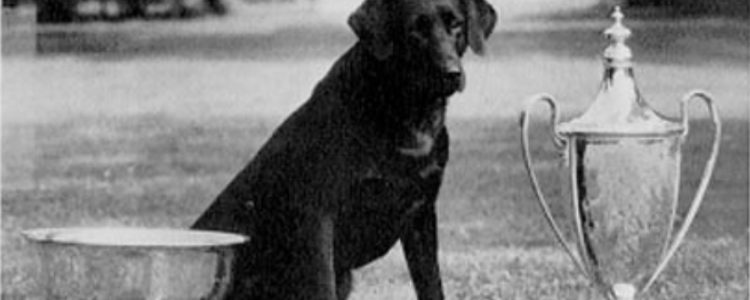
What makes a great dog? Is it genetics? Is it the way he’s raised? Is it due to training? Is it due to handling? Or is it all of the above? NFC 2xNAFC Super Chief would probably say all of the above.
SUPER CHIEF’S FORMULA FOR SUCCESS
Born in 1962, Soupy was given to August “Augie” Belmont IV by his breeder because a previous dog from the breeder had turned out unsound. The Belmonts raised Soupy on Long Island until he was six months old.
Training Greatness
At that time, Soupy was old enough to begin serious training, so Augie flew him to Rex Carr in California. Carr is called “the father of modern retriever training.”
To be trained by a legend would definitely help a dog achieve greatness.
Handling Expertise
Rex Carr often trained the owners to handle their own dogs – a task that’s probably more difficult than training the dogs. It must have worked though as Augie and his wife, Louise, handled Soupy to many field trial wins. Starting with five Derby wins by 19 months, Soupy won 40 Derby points, 112 Amateur points and 242 Open points. He also won the 1967 and 1968 National Amateur Retriever championship plus the 1968 National Retriever championship.
Soupy had a good trainer and good handlers.
Superb Genetics
What about genetics? His parents were both grandchildren of DUAL CH Grangemead Precocious. Precocious was sired by 3xNFC CFC DUAL CH Shed of Arden out of Huron’s Lady – a mixture of show, field and dual champions.
Add in two crosses each to:
- Am Eng FC Hiwood Mike
- DUAL CH CFC Little Pierre of Deer Creek
- NFC AFC Marvadel Black Gum
- Can DUAL CH Coastal Charger of Deer Creek
Plus NFC AFC CFC Cork of Oakwood Lane and NFC Tar of Arden.
Plus more Dual Champions – DUAL CH Cherokee Buck and DUAL CH NFC CFC Bracken’s Sweep.
Plus a line that includes dogs from the Sandylands show kennel through FC The Spider of Kingswere.
| FC AFC Paha-Sapa Chief II | FC Freehaven Muscles | DUAL CH Grangemead Precocious |
| Grangemead Sharon | ||
| Treasure State Bewise *** | FC The Spider of Kingswere | |
| FC Deer Creek’s Bewise | ||
| Ironwood Cherokee Chica | DUAL CH Cherokee Buck | DUAL CH Grangemead Precocious |
| Grangemead Sharon | ||
| Glen-Water Fantom | NFC AFC CFC Cork of Oakwood Lane | |
| Little Peggy Black Gum |
Click to see his 5-generation pedigree.
DESCENDANTS
Soupy was bred to a variety of bitches, some with field breeding, but also to some with show breeding. Between his pedigree and his offspring, I’d say he also had good genetics.
Some of his offspring include:
* DUAL CH Shamrock Acres Super Drive
Sire of Am Mex CH Gunfield’s Super Charger CD WC who did much to improve chocolates
* DUAL CH Royal Oaks Jill of Burgundy 2005 Hall of Fame
* NFC NAFC 2xCNFC Wanapum Darts Dandy 1992 Hall of Fame
* FC AFC Air Express
Sire of many field champions, including FC AFC Itchin’ To Go, CNFC FC Overland Express, FC AFC CFC Trieven Thunderhead, FC AFC CFC CAFC Wanapum Super Sioux, NAFC FC Winsom Cargo and DUAL CH AFC Trumarc’s Triple Threat
* FC AFC Candlewood’s Nellie B Good
Granddam of FC AFC Wilderness Harley To Go 2003 Hall of Fame and FC AFC Candlewoods M D Houston 1996 Hall of Fame
* NFC FC AFC Euroclydon (pronounced u-roc-li-don)
1993 Hall of Fame and dam of NFC FC AFC Orion’s Sky 1994 Hall of Fame
* FC Candlewood’s Super Deal
Grandsire of 3xNFC FC AFC Candlewood’s Tanks A Lot
* Super Powder QAA
Sire of NFC AFC FTCH Risky Business Ruby 1993 Hall of Fame and FC AFC Volwood’s Ruff And Reddy 2000 Hall of Fame plus grandsire of FC AFC Code Blue 2000 Hall of Fame and FC AFC CNFC CAFC Chena River No Surprise 2004 Hall of Fame
* Shamrock Acres Juego de Azar
Granddam of FC AFC River Oaks Way-Da-Go Rocky who was the sire of our Knight’s Tail Dehlia.
* Shamrock Acres Super Sioux
Dam of FC AFC Raider’s Piper Cub
* Sirion’s Super Snooper
Dam of CFC Rascal’s Super Spud who sired CNFC CNAFC Waldorf’s High Tech who sired 2xNAFC 2xCNAFC FC CFC Ebonstar Lean Mac
* Paha Sapa Greta
Dam of FC AFC Ironwood Tarnation 1995 Hall of Fame
* Cup A Soup
Dam of NFC AFC CFC CAFC Yankee Independence
* FC Shamrock Acres Super Value 1998 Hall of Fame
* Shamrock Acres Duck Soup
Dam of FC AFC CFC CAFC Candlewoods Mad Mouse 1994 Hall of Fame
* FC Wanapum Sheba
Dam of NAFC FC Kannonball Kate 1992 Hall of Fame
And several more titled offspring.
Is Soupy in our pedigrees? Yes, many times.
- Chip and all of his descendants trace to him through DUAL CH Shamrock Acres Super Drive (12 times!) and CH Gunfields Super Charger CD, DUAL CH Trumarc’s Triple Threat, FC AFC Air Express, FC AFC CFC Trieven Thunderhead, FC AFC Candlewood’s Nellie Be Good, CH K’s Jetta of Someday, AFC Shamrock Acres Whiskey Jake
- Dee and her descendants trace to him through FC AFC Canis Major’s River Bear
- Cat and her descendants trace to him through 2xNAFC 2xCNAFC FC CFC Ebonstar Lean Mac, CNFC CNAFC FC AFC The Marathon Man, FC AFC CFC CAFC Candlewoods Mad Mouse (twice) and NFC FC AFC Westwind Supernova Chief
By the way, if you follow horse racing you’ll recognize the family name. Although Augie also owned race horses, he was not as active as his grandfather, August Belmont II, or great grandfather, August Belmont, who founded Belmont Park and for whom the Triple Crown race was named.
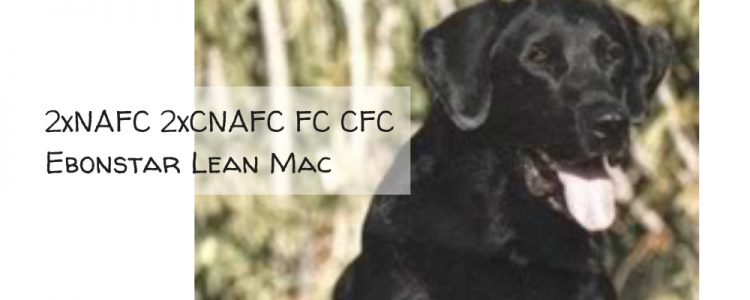
Out of curiosity, I looked into the pedigree of 2xNAFC 2xCNAFC FC CFC Ebonstar Lean Mac who was probably the most influential field Labrador Retriever in recent history.
Why was he so influential?
He earned a Field Championship (FC) and an Amateur Field Championship (AFC) in BOTH the US and Canada.
He also won the National Amateur Field Championship (NAFC) twice and he won the Canadian National Amateur Field Championship (CNAFC) twice. (Learn more about title abbreviations.)
And he produced many dogs who earned hunt test titles, field championships and won more national championships.
But today we’re going to look at some of his ancestors. So who does he descend from?
Here’s his 3-generation pedigree:
| CNFC CNAFC Waldorf’s High Tech | CFC Rascal’s Super Spud | NAFC FC Ray’s Rascal |
| Sirion’s Super Snooper | ||
| Itch’s Flying Tiger | FC AFC Itchin’ To Go | |
| Thor’s Tiger Lillie | ||
| Ebonaceae Princess WCX QAA | Trieven El Conquistador | FC AFC CFC Trieven Thunderhead |
| Trieven High Speed | ||
| Skookum’s Sky Raider | CFC CAFC Virdon’s Tuktoyaktuk | |
| Wilkie’s Cinderella Liberty |
It’s when you go back further that you find ancestors some people might find surprising –
3xNFC CFC DUAL CH Shed of Arden (19)
DUAL CH Matchmaker for Deer Creek (4) – and his sire and grandsire:
DUAL CH CFC Little Pierre of Deer Creek (15)
Am Eng CH Banchory Trump of Wingan (4)
DUAL CH Cherokee Buck (6) – and his sire:
DUAL CH Grangemead Precocious (12)
Can DUAL CH Coastal Charger of Deer Creek (16) (another son of Little Pierre)
NFC DUAL CH CFC Bracken Sweep (8)
CH Whygin Poppitt (3)
Can DUAL CH Dart of Netley Creek (3)
FTCH CAN DUAL CH Treveilyr Swift (1)
Eng Can CH Sandylands Jilly (1)
DUAL CH CFC Ridgewood Playboy (1)
DUAL CH AFC Hello Joe of Rocheltree (1)
CNFC CAN DUAL CH AFC Stormy Of Spirit Lake Gal (1)
ENG DUAL CH Staindrop Saighdear (1)
CAN DUAL CH CAFC Netley Creek’s Black Drake (1)
(The numbers following the names are the number of times that dog shows up in his 10 generation pedigree.)
Maxx is very well known in the field trial and hunt test communities, but many people don’t realize how many SHOW DOGS are in his pedigree.
To be fair, many of these dogs lived during a time when Labs competed in both field trials and dog shows and could earn championships in both. There hasn’t been a DUAL CHAMPION Labrador since the 1980s though.
There are also numerous FC, AFC, NFC and NAFC dogs, such as NFC 2xNAFC Super Chief, NAFC FC CFC Guy’s Bitterroot Lucky, NFC AFC Massie’s Sassy Boots, Eng IGL CH FTCH Glenhead Zuider, NFC AFC CFC Cork of Oakwood Lane, NAFC FC Ray’s Rascal, NFC AFC Marvadel Black Gum.
I had two of Maxx’s granddaughters, including Clubmead’s Dark Crystal, and many of my current dogs descend from her. While her pedigree has several American and Canadian FC and AFCs, plus a healthy dose of National Field Champions, if you follow her maternal line you’ll find some show dogs in her pedigree too. One top dog – AM CAN CH Shamrock Acres Light Brigade – shows up three times. By the way, CH Whygin Poppitt, who shows up in Maxx’s pedigree, is also the grandsire of Light Brigade.
It wasn’t that long ago Labradors came from one gene pool. There weren’t “American” Labs or “English” Labs, they were all just Labrador Retrievers.
Does that make you stop and think about recent breeding choices?

